Any great trip involves a bucket list of food, do not miss these Jamaican fruits as they’ll make your holiday.
Jamaica is a beautiful country with gorgeous beaches, fantastic music, friendly locals and SO much good food and drink.
But if you step off the beaches and into the markets you’ll find fruit in Jamaica you’ve never had at home.
Jamaica fruit tell a story of its history. They share Jamaica’s story of explorers, labourers and slaves.
Some of it is indigenous to the island, some were brought by Christopher Columbus and many are thought to have arrived with Captain William Bligh.
On a single trip to Jamaica you may not be able to try all of the fruit on this list.
But I can guarantee attempting to find them will be one of the best adventures you have.
Ackee – Jamaica National Fruit
Perhaps the most important Jamaican fruit and Jamaica’s national fruit. It is also one half of the country’s national dish – ackee and saltfish.
Ackee is originally from West Africa, but has been in Jamaica since the 18th century and is now found throughout the island. It is a large fruit with black seeds.
It is from the lychee family and when cooked it kind of looks like scrambled eggs, or some say brain. It is one of many Jamaican fruits that must be cooked.
It isn’t easy to cook with so go somewhere trustworthy as there are parts that inedible and unriped ackee can cause Jamaican vomiting sickness.
It’s often served as a breakfast dish so if you’re staying somewhere with a buffet it could be best to try there.
If you haven’t grown up with ackee it is an acquired taste.
I’m thankful for trying it at a hotel as it wasn’t my favourite Jamaican food. But hey you won’t love everything.
Ackee season is January through March and June through August.
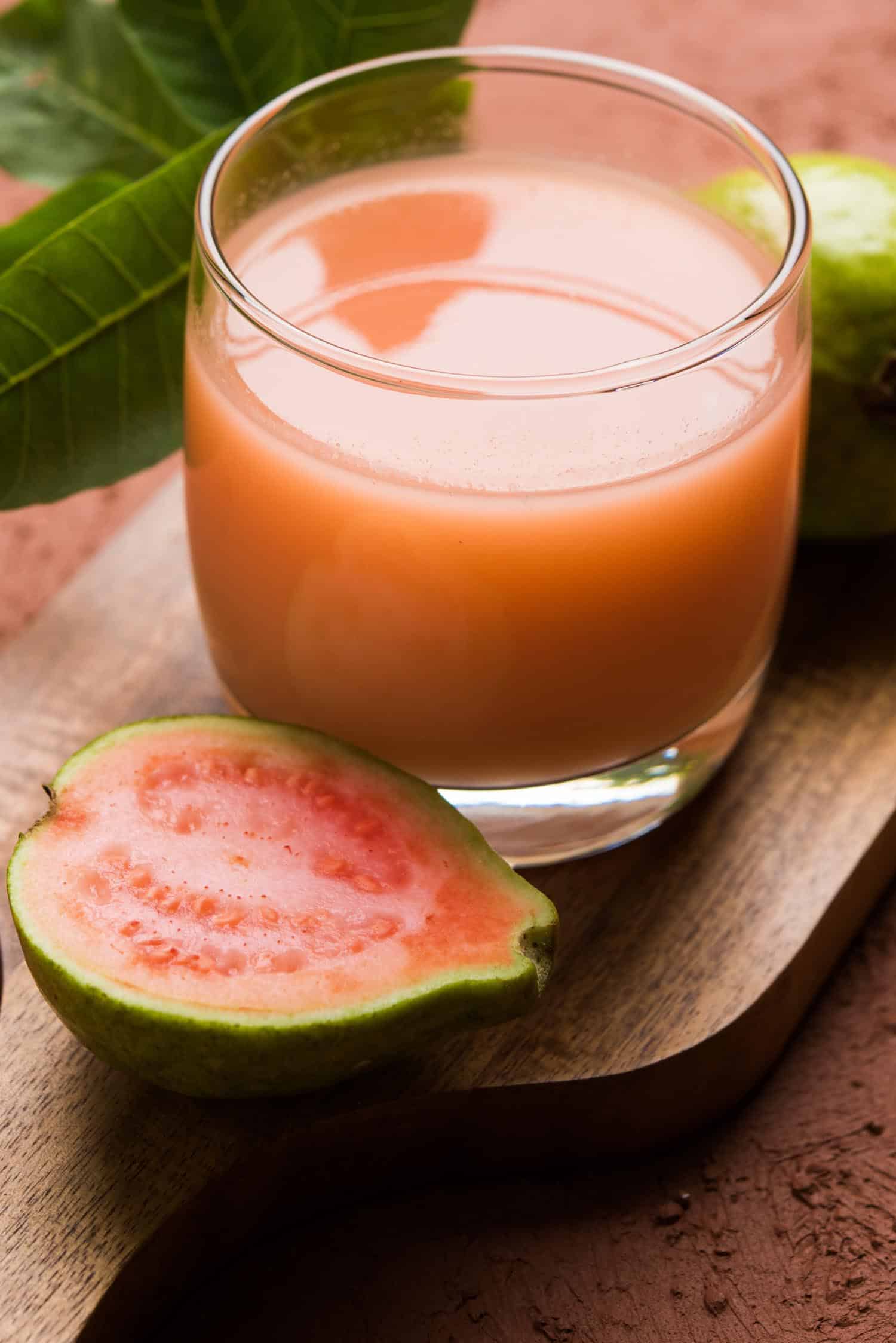
Guava
One of my absolute favourite Caribbean fruits. Guava can be tart and so unless it’s prime season when the fruit is very ripe, it is often turned into a juice.
It’s also common to have it as a sweet paste or ham and served with a salty cheese.
It’s also common to make guava cheese, which isn’t cheese at all. Instead, it is like a thick dried fruit paste snack, it should really be called guava fudge, maybe?
Thankfully it is one of the Jamaican fruits that is easy to detect ripeness. When it ripens it turns from green to yellow.
And it smells so delicious.
Although it’s more common to see Jamaica guavas about the size of a large lemon, it is possible to find them as big as a grapefruit.
They are usually pink but sometimes you can find white guavas, which are also popular fruit in Malaysia.
Pineapple
I don’t think I really more of an appreciation for pineapple, until I visited Jamaica.
I ate my weight in pineapples in Maui, along with so many other Hawaiian fruits, but I didn’t learn much about them.
However, Croydon Plantation is a popular destination to learn about Jamaican history and the fight to end slavery.
I loved it here because so many plantations in other countries really skim over the issue that these beautiful homes and farmlands were made possible by slavery.
Today it’s still a working plantation with 17 species of pineapple along with cacao and Jamaican fruits.
I had zero idea pineapple was so varied, here you can try whatever is in season at the time.
Pineapple was brought to Jamaica by the Tainos – the same group from South America that became the first inhabitants of Cuba (later killed by the Spanish) and many other Caribbean islands.
If you don’t visit the Croydon Plantation you can still find the four most common varieties of pineapple in Jamaica – cowboy, ripley, smooth cayenne and sugarloaf.
They all look different, have unique flavours and textures.
Today you can find five golden pineapples on Jamaica’s coat of arms, which is also on Jamaican money.
Almond
This may blow your mind but almonds are part of the peach family.
You can eat the flesh of the almond fruit when it is ripe or you can allow it to dry out and eat the dried pit, or almond.
Jamaican Snacks
People rarely speak of almond fruit because for a few short weeks in spring they are ripe. And you need to eat them the same day they were picked.
But it is such a treat to pass by an almond tree, pick one and it is read to eat.
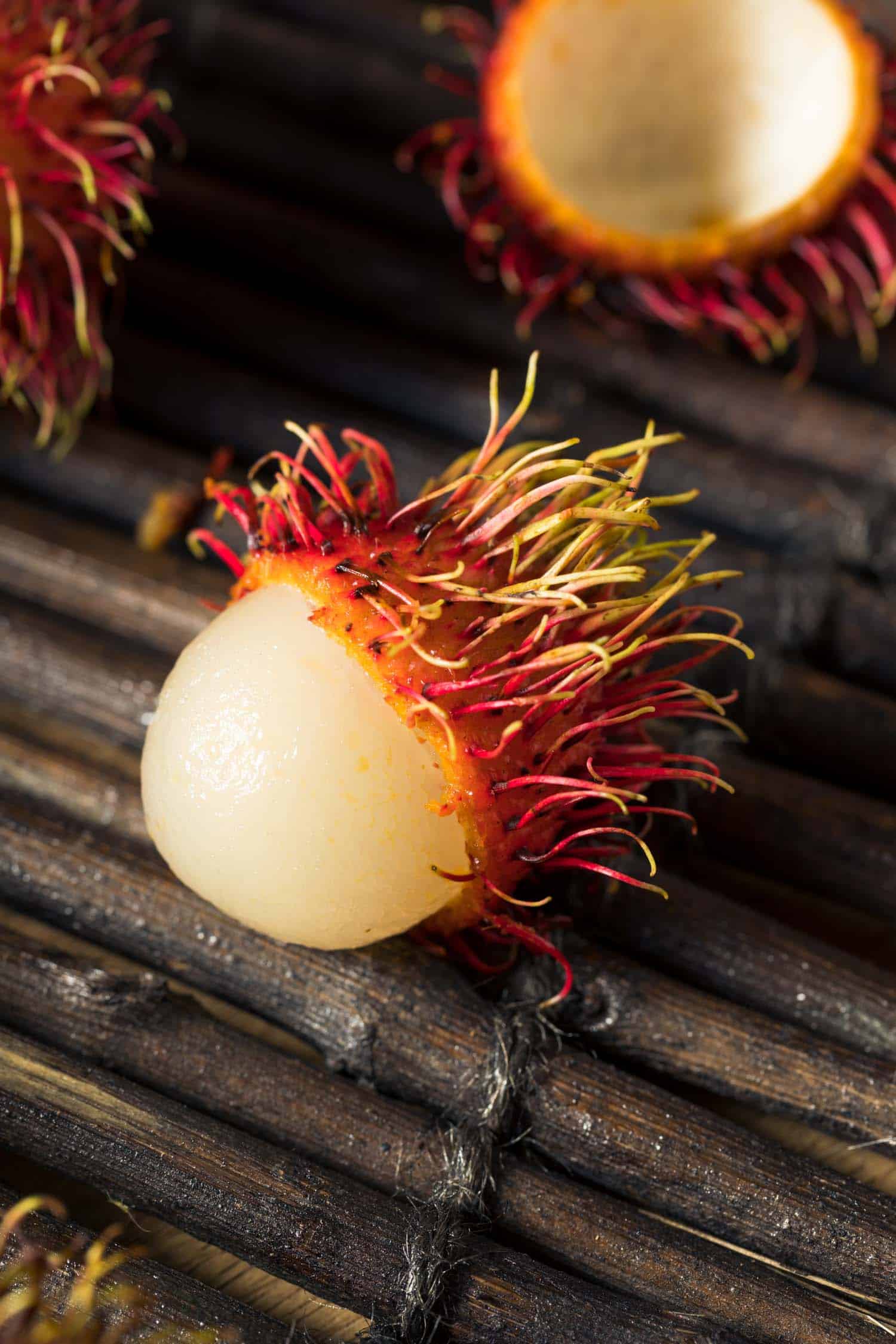
Rambutan
Although rambutan are originally from Southeast Asia and one of the most popular fruits in Cambodia. You can find them throughout Latin America and the Caribbean.
Best described as a hairy lychee fruit. You need to open them up and suck the flesh off the core.
They are a great refreshing snack but also have a short season in late winter. If they are in season it’s best to try local markets.
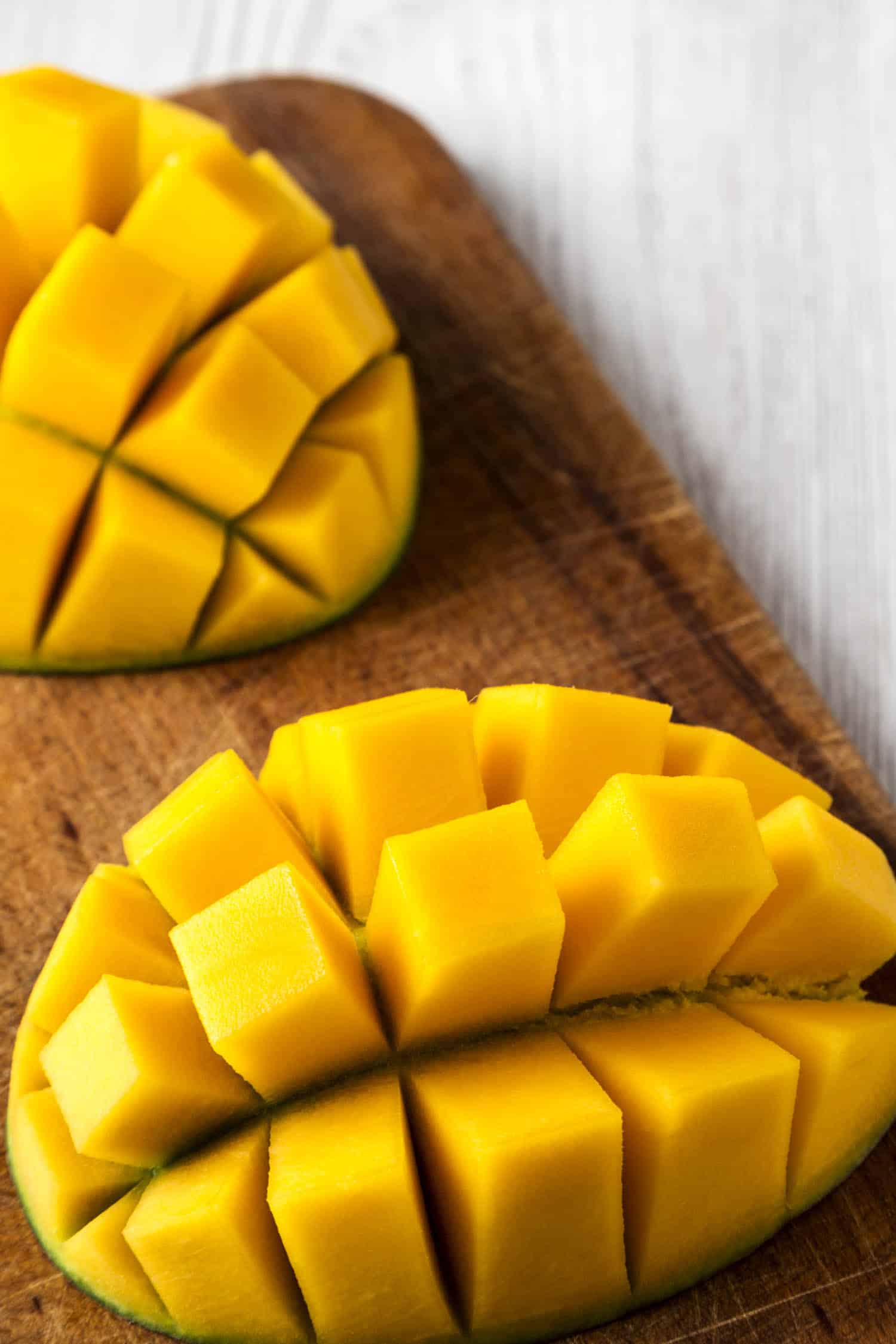
Mango
Mango is absolutely one of the most consumed Jamaican fruits, locals love them.
And unlike what we have imported, there isn’t just the yellow or green type of mango – they are SO many types of Jamaican mangoes.
It is believed that mangoes originated in India, from over 4000 years ago. But mangoes are considered a local Jamaican fruit.
Jamaican Mango Names
- Beef or beefy
- Black aka black sweety, blackie, dunkell,green gauge, kidney
- Bluie
- Bombay or Bambay in patois
- Common aka hairy aka stringy
- Come see aka sweetie, sweetie come brush me
- East Indian
- Emperor
- Fine skin
- Graham aka gryam
- Green aka green and red, green skin
- Hamilton
- Hayden (also popular in Hawaii)
- John Belly Full
- Julie or St.Julian
- Keith aka keitt
- Lady Finger
- Long aka longy
- Millie
- Number 7
- Number 11
- Parry
- Paw paw aka carrot
- Pint o Water
- Plummie
- Robin or Rabin
- Tommy Atkins
- Turpentine aka peach mango
This list is getting so long but there are more Jamaican mango names!
Want to strike up a conversation with locals, ask them what the best Jamaican mango is!
Everyone has a different opinion and some people passionately debate why their beloved mango variety is best.
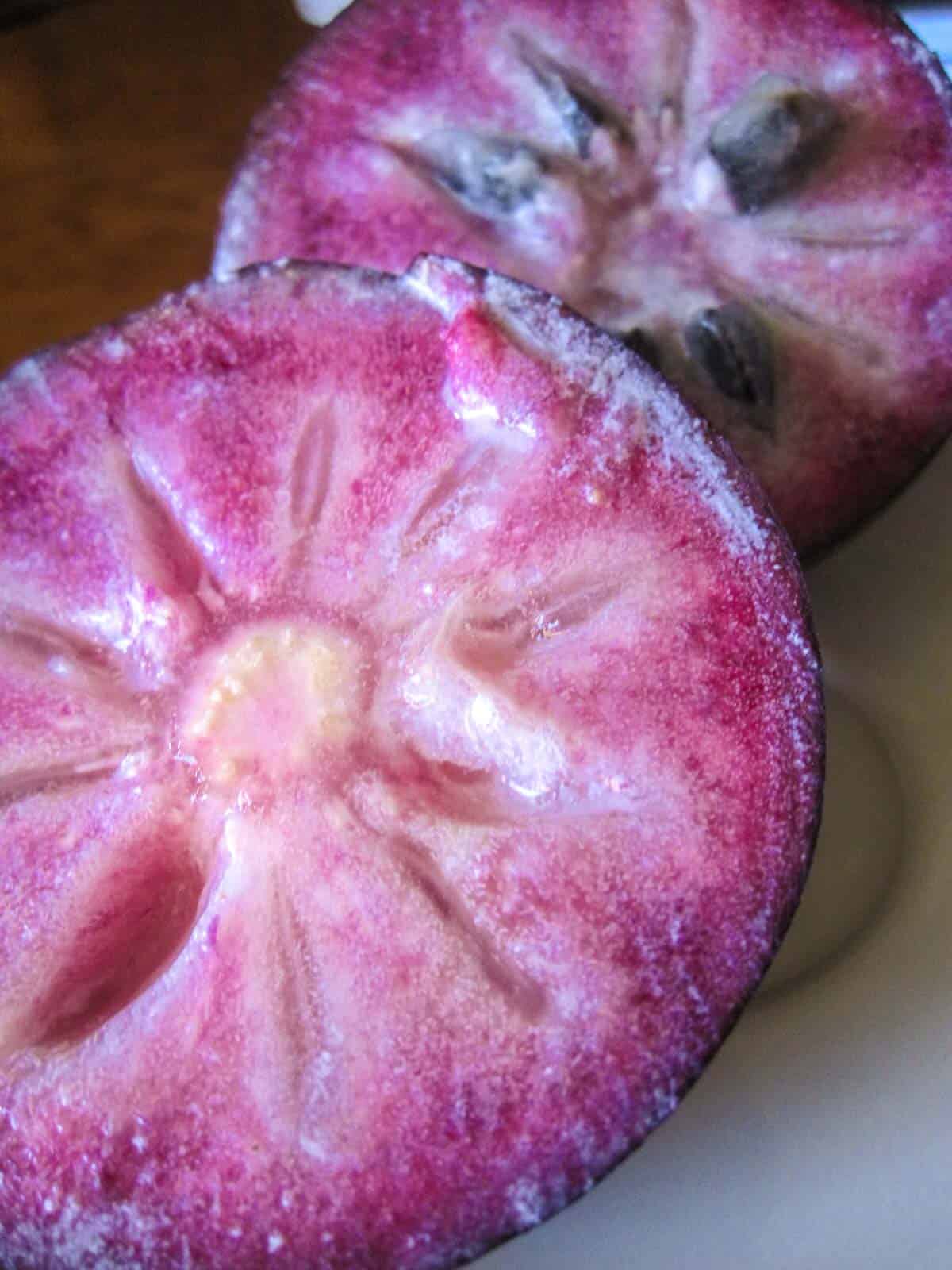
Star Apple
You cannot eat the skin of this Jamaican fruit but the flesh inside is so delicious.
It is often called matrimony and combined with sour orange juice (seville oranges) to make a juice of the same name.
Once you break through the inedible skin, the inside of this vibrant fruit is milky and Jello-like, similar to a persimmon.
In Jamaica, it is often prepared with sour orange juice, a combination called “matrimony.”
The name is quite simple, when you cut into star apple it reveals a star interior. Most often star apples are purple but you can also find green fruit with white flesh.
It’s common to eat somewhat like a kiwi. Cut the fruit in half and scoop out the fruit with a spoon. It has a sweet taste, a bit like a persimmon.
Star apple season in Jamaica is November through March.
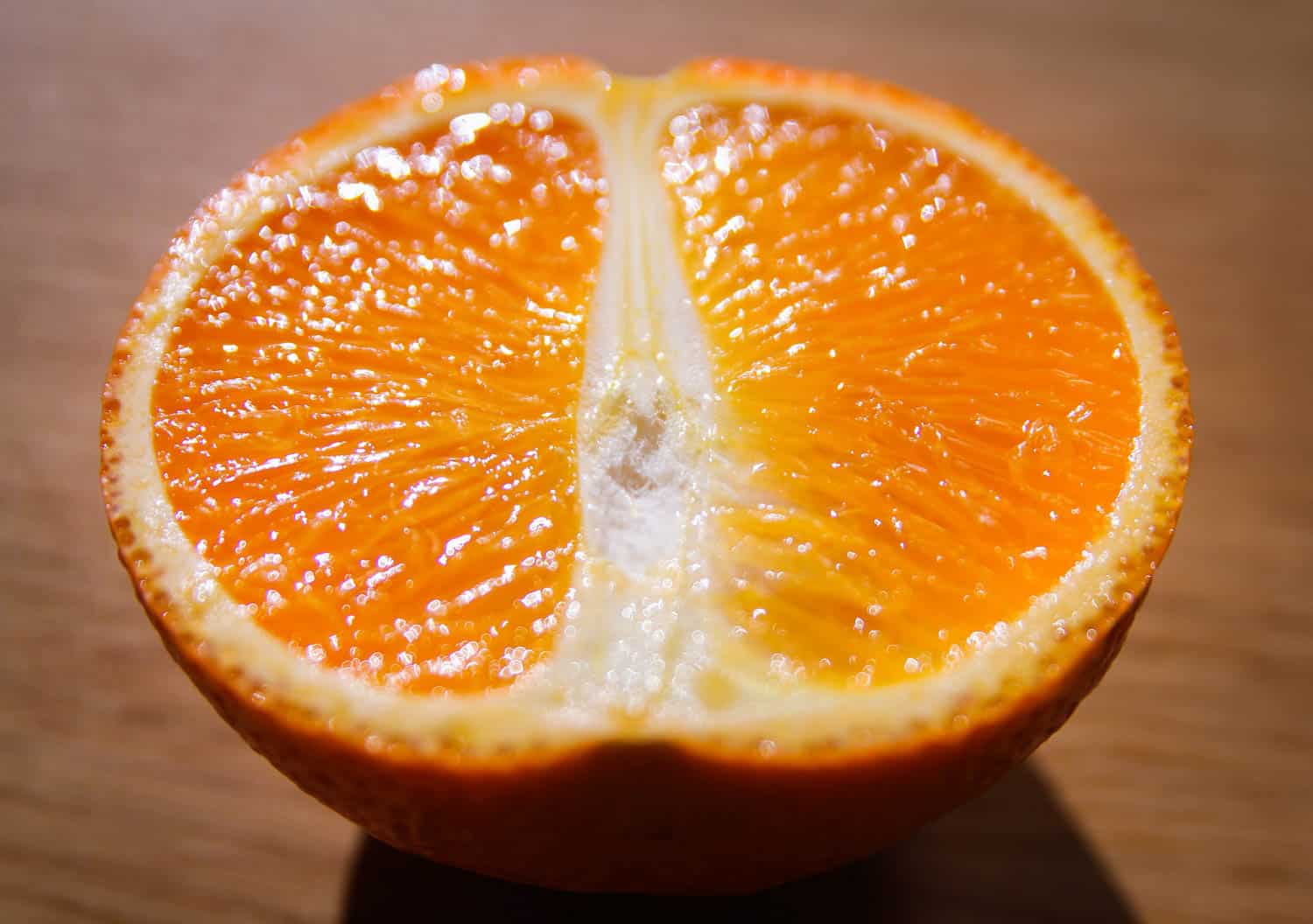
Ortanique
Also known as tangor, this is a Jamaican fruit hybrid from Manchester. It is a cross between a mandarin orange and sweet orange.
The name tangor is tang from tangerine and or from orange.
The name ortanique is also created from orange, tangerine and also unique.
This citrus fruit was developed in Jamaica, a cross between an orange and a tangerine. The name is derived from the words “orange, tangerine and unique”.
It looks like an orange but is a bit more flat, with thicker skin and often juicier.
Cacao
If you’ve never visited a chocolate producing region, you may not have realized that chocolate is actually a fruit!
I first learned this staying with the Bribri indigenous people when they shared typical Costa Rican fruit.
Before that I’m not sure how I thought chocolate was made as I had only ever seen cacao nibs.
The cacao fruit pod holds beans but they taste nothing like chocolate. The fruit is sweet and tangy before its roasted and processed for chocolate
To eat cacao you simply take one of its pods and suck on the outside flesh. Be sure to spit out the bitter seed.
You can find cacao fruit wherever coffee is grown. It’s also a popular Bali fruit for its flavor.
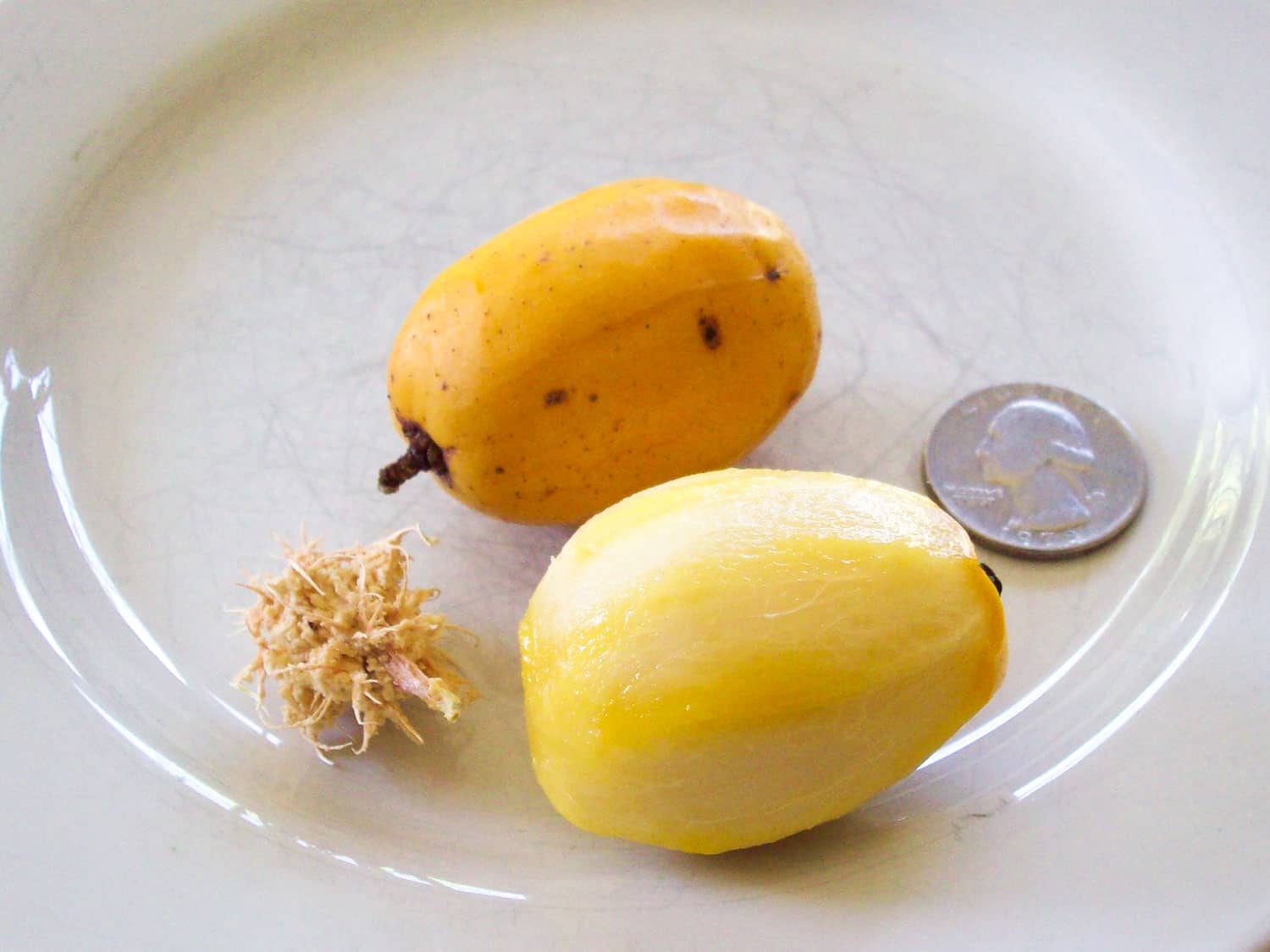
June Plums
Originally a Hawaiian fruit, June plums arrived in the late 1700s but they are also common in Indonesia and Sri Lanka where they are eaten both savoury and sweet.
As a ripe fruit, June plums are both sweet and tart. They make for a great Jamaican drink, dessert or preserves.
Unripe green plums can be eaten with salt and pepper or stewed with other ingredients.
June plum season in Jamaica is September through mid-January.
Sweetsop
Sweetsop is one of the most popular Jamaican fruits, although no one really knows if it is native to the country or another fruit brought by the Spaniards.
It is related to the soursop fruit and also cherimoya. It has a sweet custardy taste that is fantastic as a juice, ice cream and other desserts.
Sweet sop season in Jamaica is April through July.
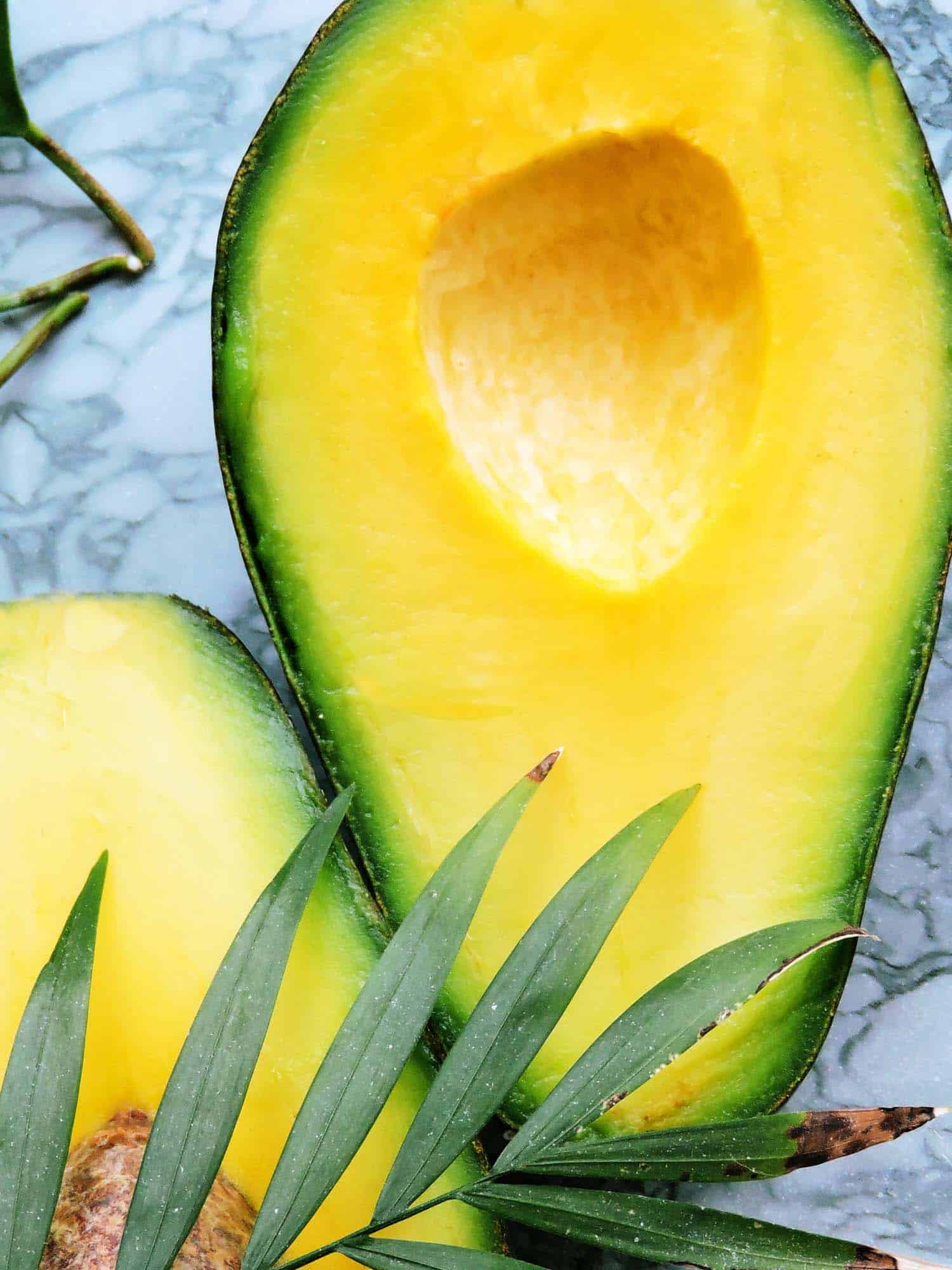
Jamaican Pear
Avocado is very popular in Jamaica but if you want one you’ll need to ask for a pear.
Jamaican pears have been around for centuries and you can find them in backyards.
In peak season an avocado tree can have hundreds of fruit.
The most common way to eat this Jamaican fruit is to either replace butter on a sandwich, or as the common snack in Jamaica called bulla and pear, which is avocado slices on a round spiced cake called bulla.
Avocado season in Jamaica is August through December.
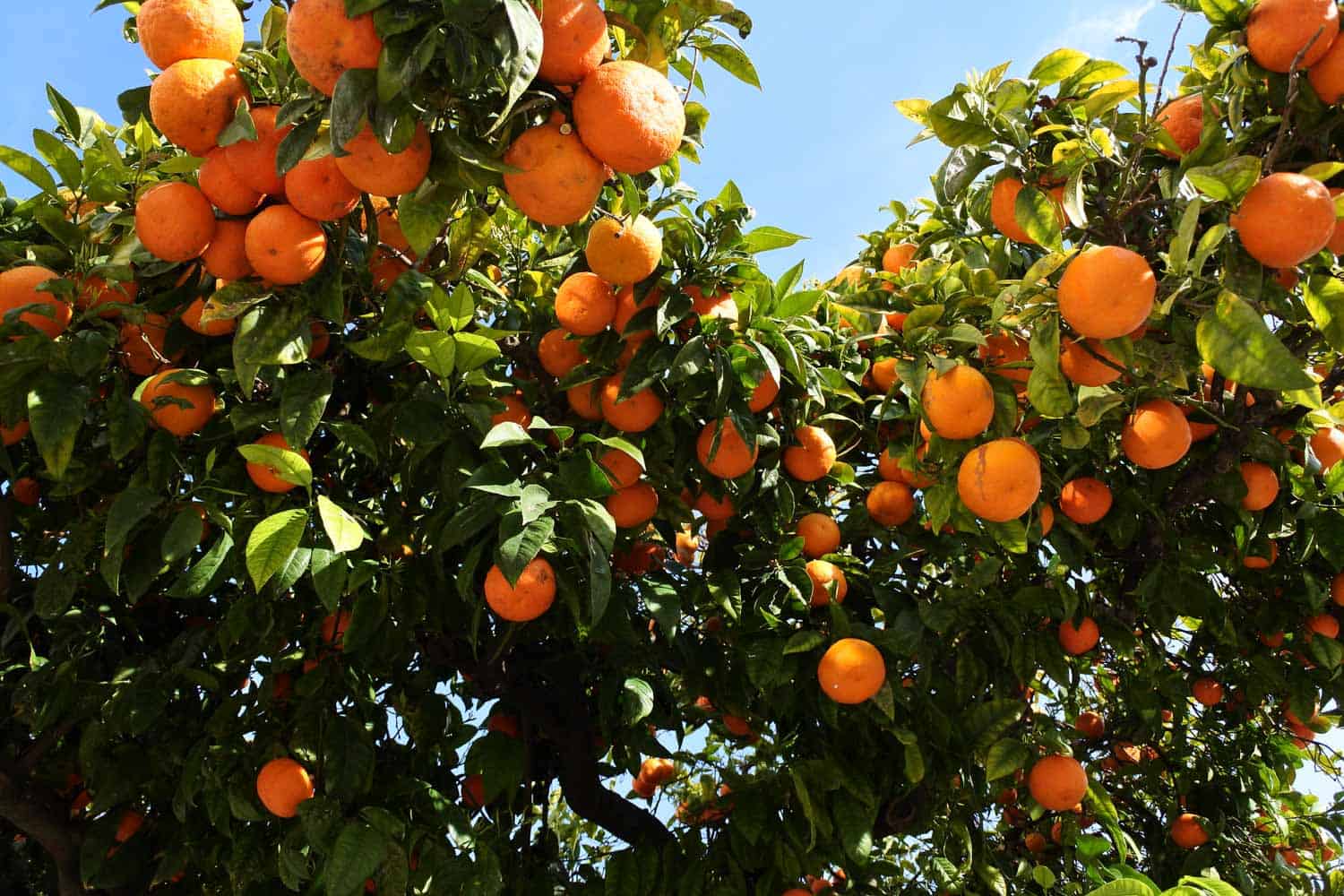
Sour Orange
Also known as Seville orange, it is also common used in Cuban cuisine and food in Mexico.
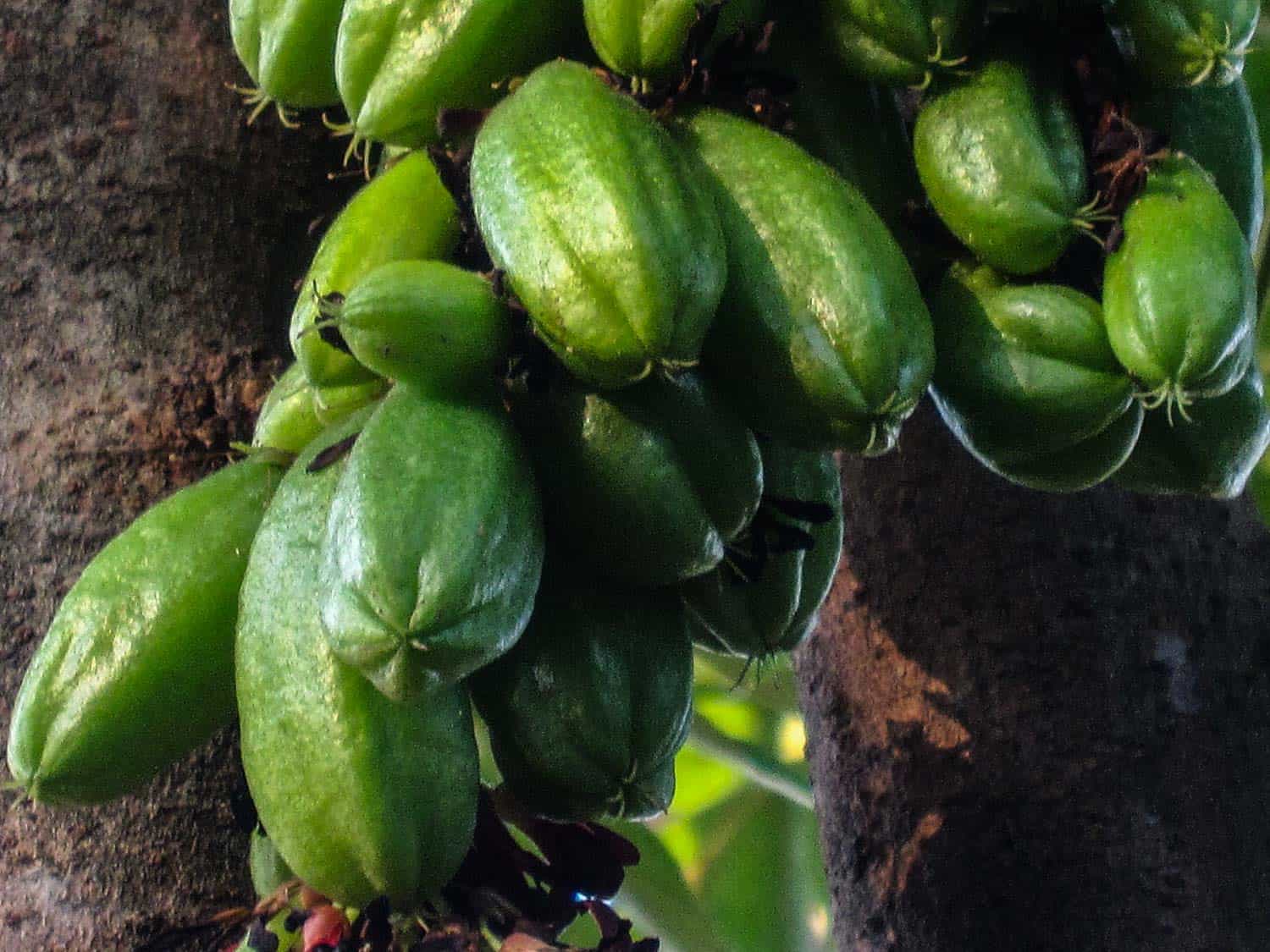
Blim Blim
The Jamaican fruit and tree name for averrhoa bilimbi, an evergreen tree that grows through the Caribbean and Guyana.
It is originally from Malaysia and Indonesia and is related to the star fruit tree, which you can see as the ends of the blim blim almost have five sides.
It is known by many different names like sowry fruit, souri fruit, tree sorrel and sour barge.
Perhaps the best one is cucumber tree as it looks like cucumbers growing from a tree.
It’s one of the many sour Jamaican fruits and so you can find it pickled or eaten with salt.
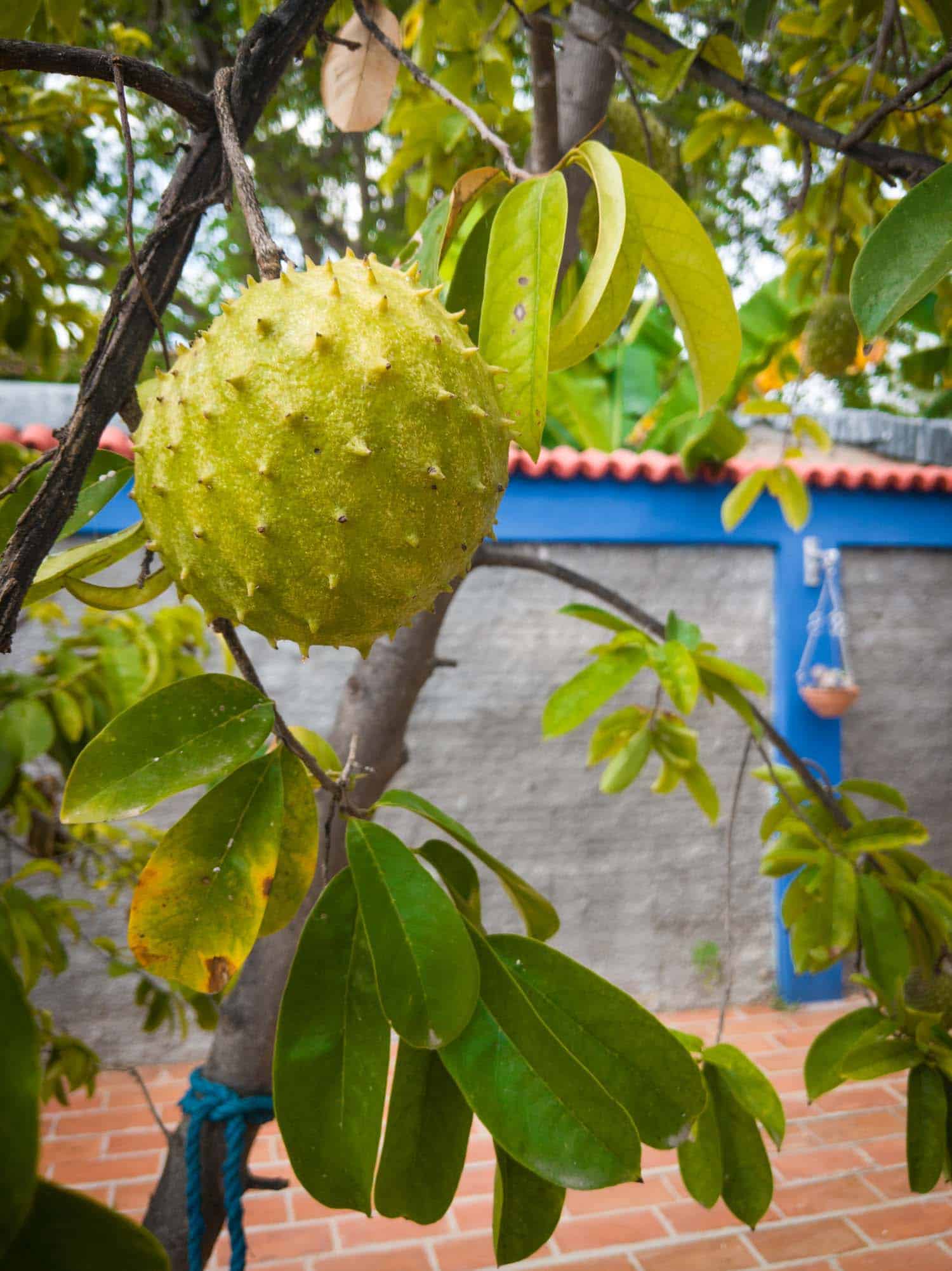
Soursop
Related to the sweetsop, but you can differentiate easily as the soursop fruit has spikes rather than bumps on its peel.
Inside it also has a white pulpy flesh and its actually not sour at all but it can be a bit acidic. It tastes almost like pineapple and banana mixed together and makes for a fantastic drink.
Soursop season in Jamaica is November through March.
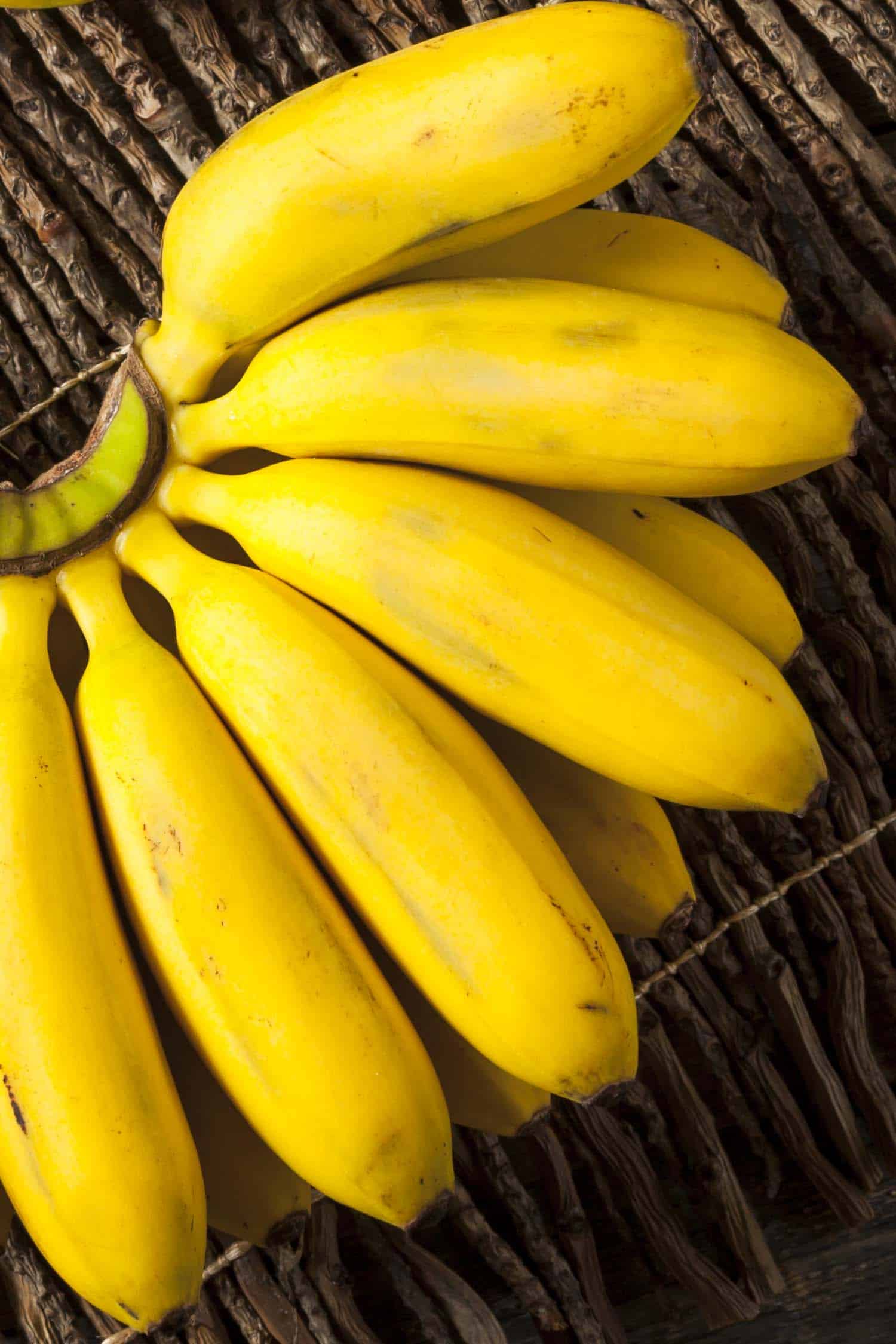
Honey Banana
Baby bananas that can vary in colour from yellow to reddish. They are shorter and fatter than the typical Cavendish bananas we eat at home.
Jamaica as the first country in the Americas to commercially produce bananas.
It’s believed it came by way of Martinique with a French botanist named Pouyat, although bananas are originally from India.
Jack Fruit
Perhaps one of the most popular Jamaican fruits with vegans worldwide, jackfruit is praised for its starchy flesh and its ability to mimic meat like pulled pork.
When it’s unripe it is savoury and can be used as a textural meat substitute. When it ripens it gets quite fruity and sweet, and makes for a great dessert and juice.
A single jackfruit can weigh up to 100 lbs and so in Jamaican markets it is often cut into smaller, more manageable portions.
It is considered a healthy fruit, high in calcium and a number of vitamins but also a low-glycemic starch.
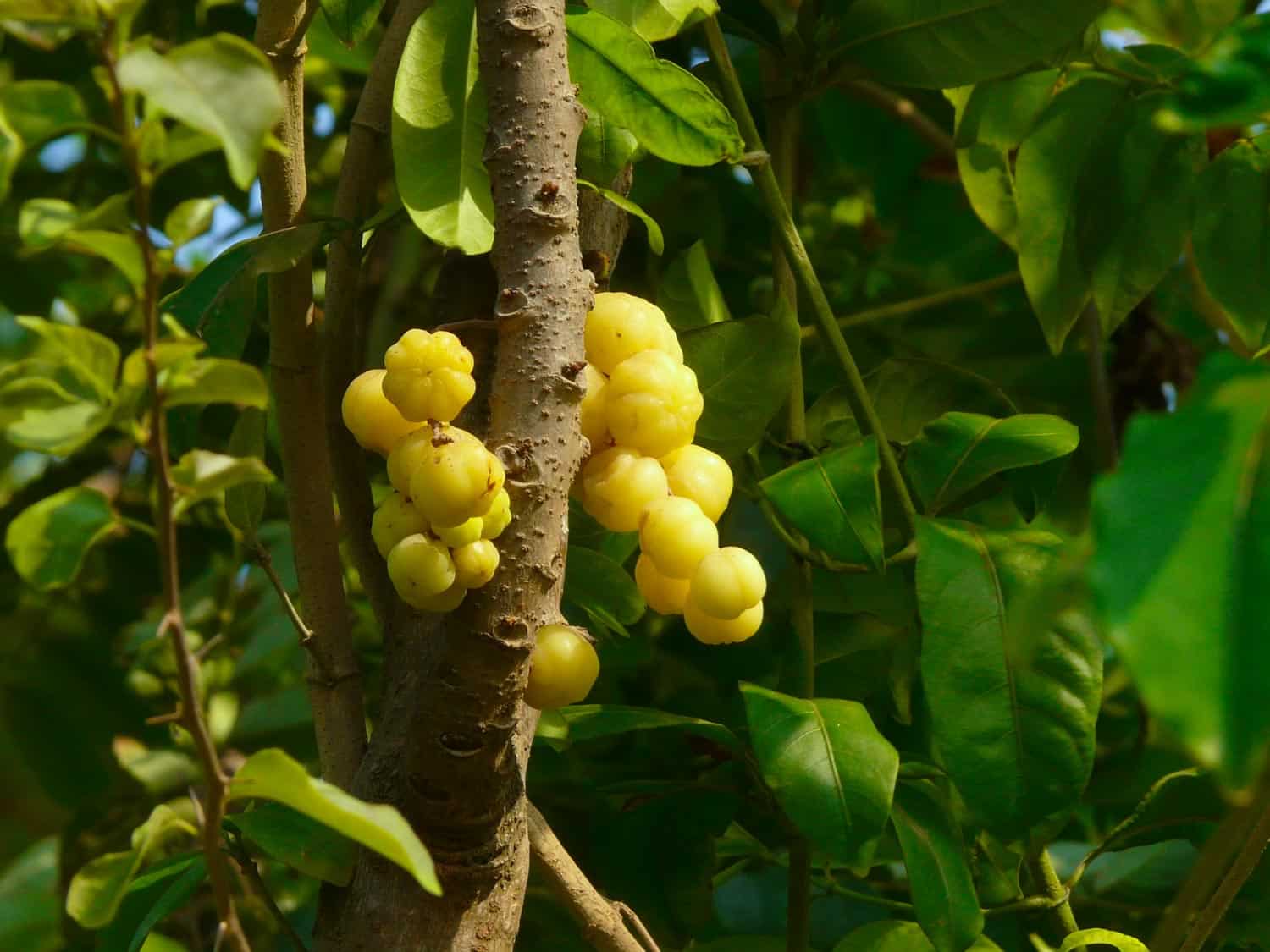
Jimbilin
So there are two fruits in Jamaica called jimbilin depending on where you are from.
One of them is starfruit and the other is called otaheite gooseberry (phyllanthus acidus).
Interestingly, starfruit/kamranga and Jamaican gooseberries have a similar flavour profile and use.
They are both tart with a high acid content and while it’s possible to eat them raw, they are better combined with sugar and spices for a preserve or juice.
They are native to South East Asia where the Thai fruit is known as star gooseberry. Although they are also a Hawaiian fruit and found through the Caribbean islands.
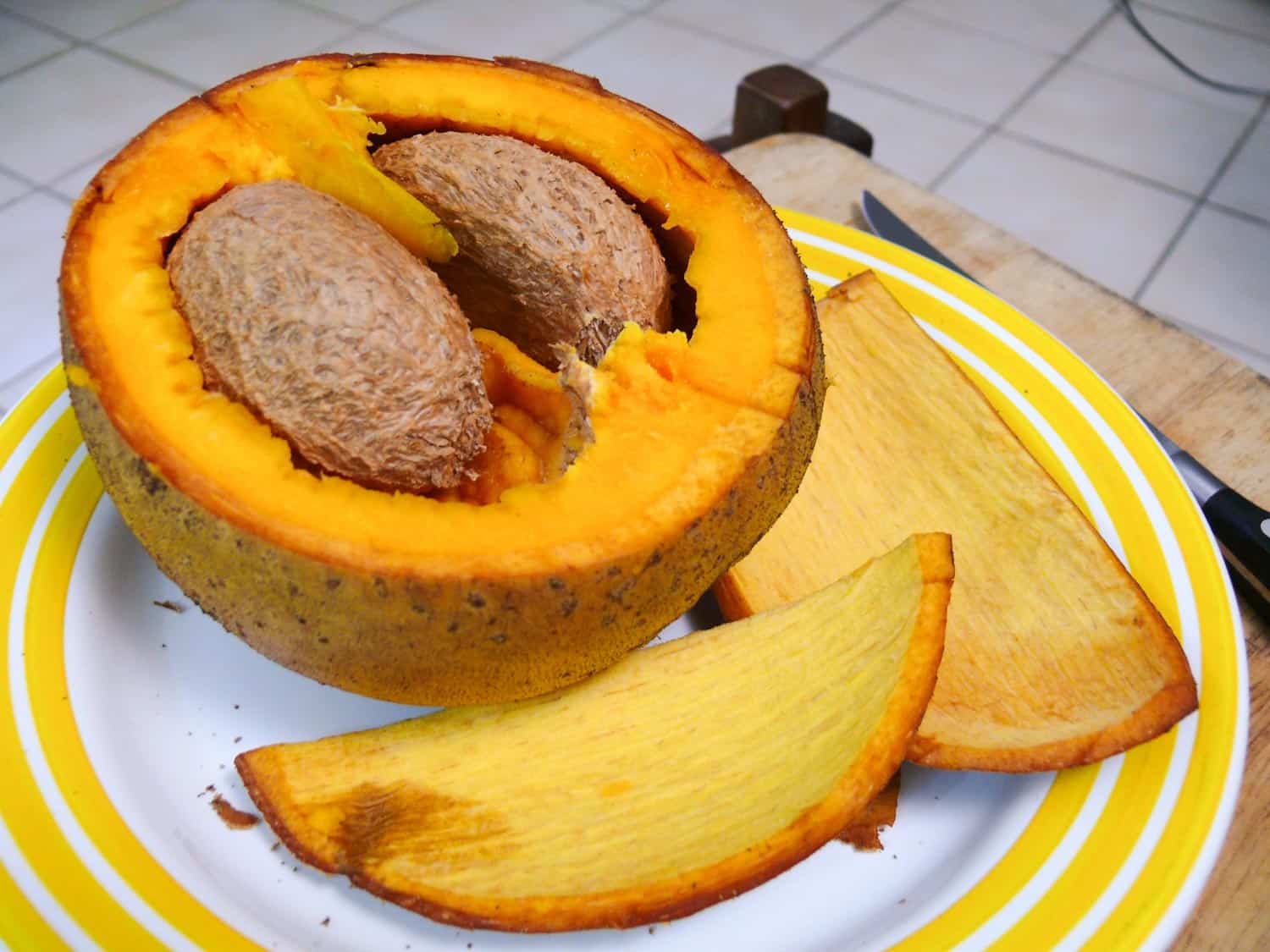
Mammee Apple
Not to be confused with mamey, the most popular Cuban fruit. Mammee apple is also known as the Santo Domingo apricot or South American apricot.
It’s also one of the most popular fruits in Nicaragua.
I think this better explains it than calling it an apple because it has a pit like an apricot and tastes like an apricot.
Also it’s not an apple, it is actually a berry related to the mangosteen.
In Central America they also call it mamey amarillo or yellow mamey. It can be eaten raw, but it is also often stewed or made into preserves.
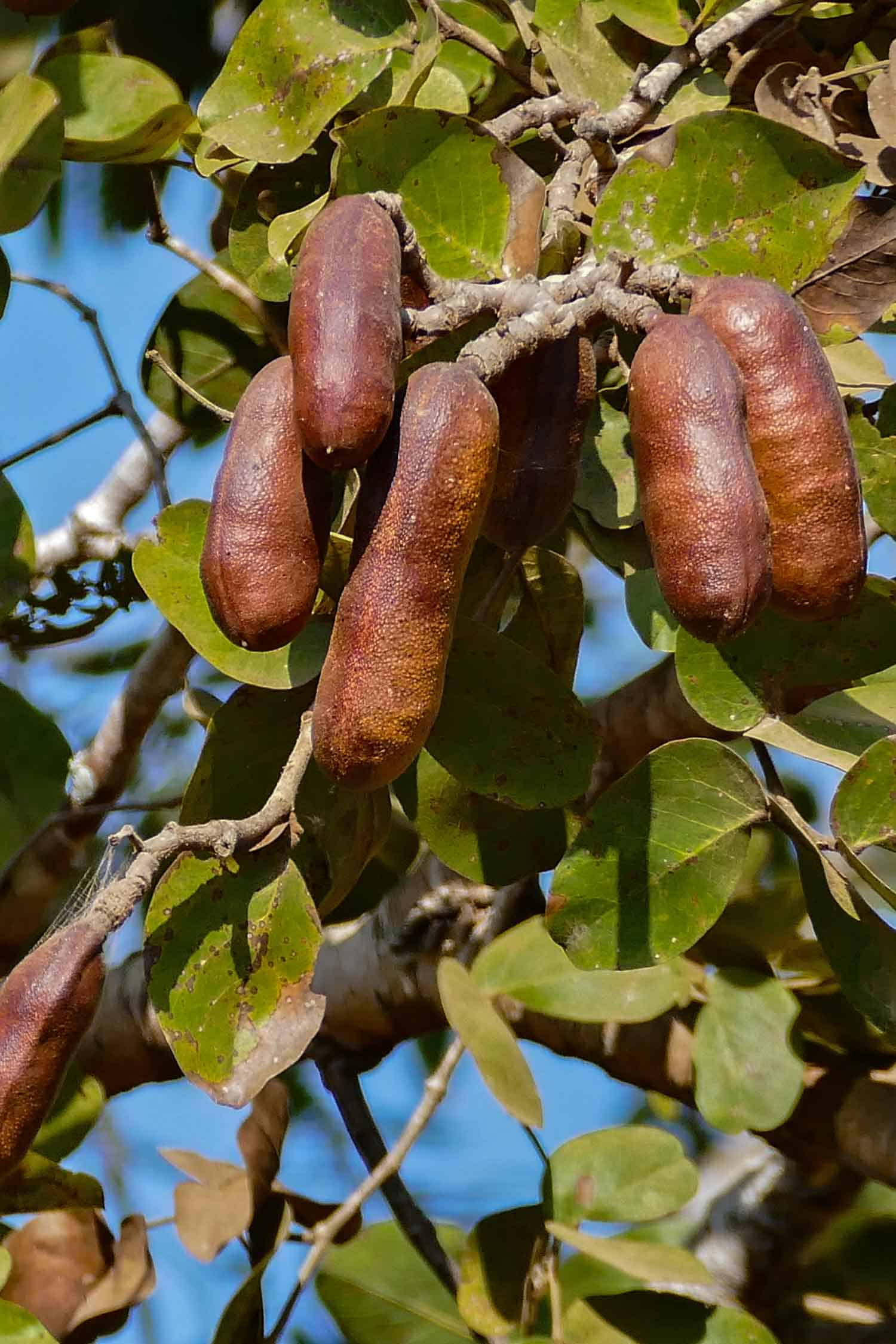
Locust
One of the more curious Jamaican fruits, it is also known as stinking toe, because the locust tree has pods with seeds making it look like giant toes on a tree
These pods are not easy to open and often require a hammer or big rock.
The pods have a dry texture and so they are often grated over a strainer to make flour that is used for baking or a fruit smoothie.
A bit like durian, it smells horrible but the taste is much better.
If you’re looking to lose weight its best to stay away as the Jamaican stinkin toe is high is carbohydrates and people believe it makes you hungry. Also it’s also an aphrodisiac.
It’s a common Brazilian fruit in the rainforest, but known as Jatobazeiro.
Breadfruit
Breadfruit may just be one of the most nutritious fruits in the world.
It looks like a jackfruit but it can be a number of different sizes and shapes. I visited the Breadfruit Institute in Maui where they have over 300 varieties – I liked it so much I went back again.
It is an excellent substitute for bread or potato in any recipe that requires a starch and it’s much more nutritious.
It was originally Polynesian but made its way to Caribbean islands and is also common in Barbados.
Barbadian food: 23 Bajan Dishes to Try
Jamaicans are also responsible for taking it to Costa Rica when they went there to work on the railroad.
It grows so easily and is now a common Costa Rican food known as fruta de pan.
Breadfruit is so versatile. It can be boiled, baked, grilled and even deep fried.
When it’s over ripe it is like a sweet custard you can spoon right out of the fruit.
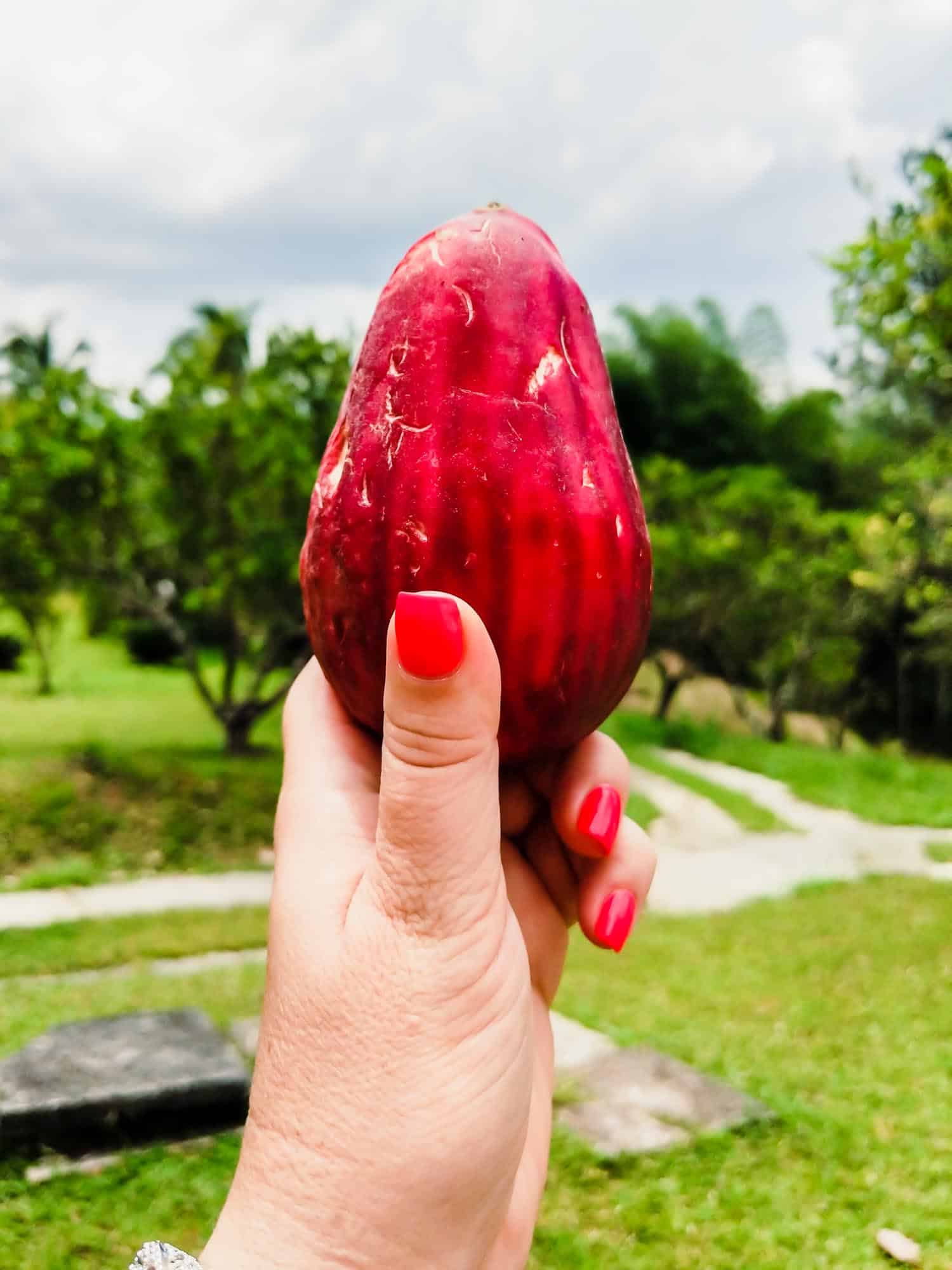
Otaheite Apple
From the South Pacific islands, Otaheite (pronounced O-Tahiti) apple is also called Malay rose apple, mountain apple, coco plum and Ethiopia apple.
While it looks somewhat like an apple with a red skin, it is more like a pear shaped fruit. It feels and tastes more like a pear with a light, spongy flesh.
It’s become so popular you can find it around the world, including as one of the most popular Vietnam fruits and common fruits in Bali.
Otaheite apple season in Jamaica and February through April.
Cherries Guinep
Known in other countries as Spanish lime, these Jamaican fruits are neither limes nor cherries.
About the size of a small ping pong ball, you need to break open the skin to suck the flesh off a pit – much like you would with a rambutan or lychee fruit. And they taste like a mixture of lemon and lime.
Cherry guineps also grow throughout Latin America and thrive in dry forests where they can be quite tall.
They are also called ganespas, limoncillo, mamoncillo, or quenapas. In Barbados it is called ackee. How’s that for confusing?
No matter what you call it you must eat them with care as this Jamaican fruit juice stains and its so tough to get out.
Cherry guinep season in Jamaica runs August through October.
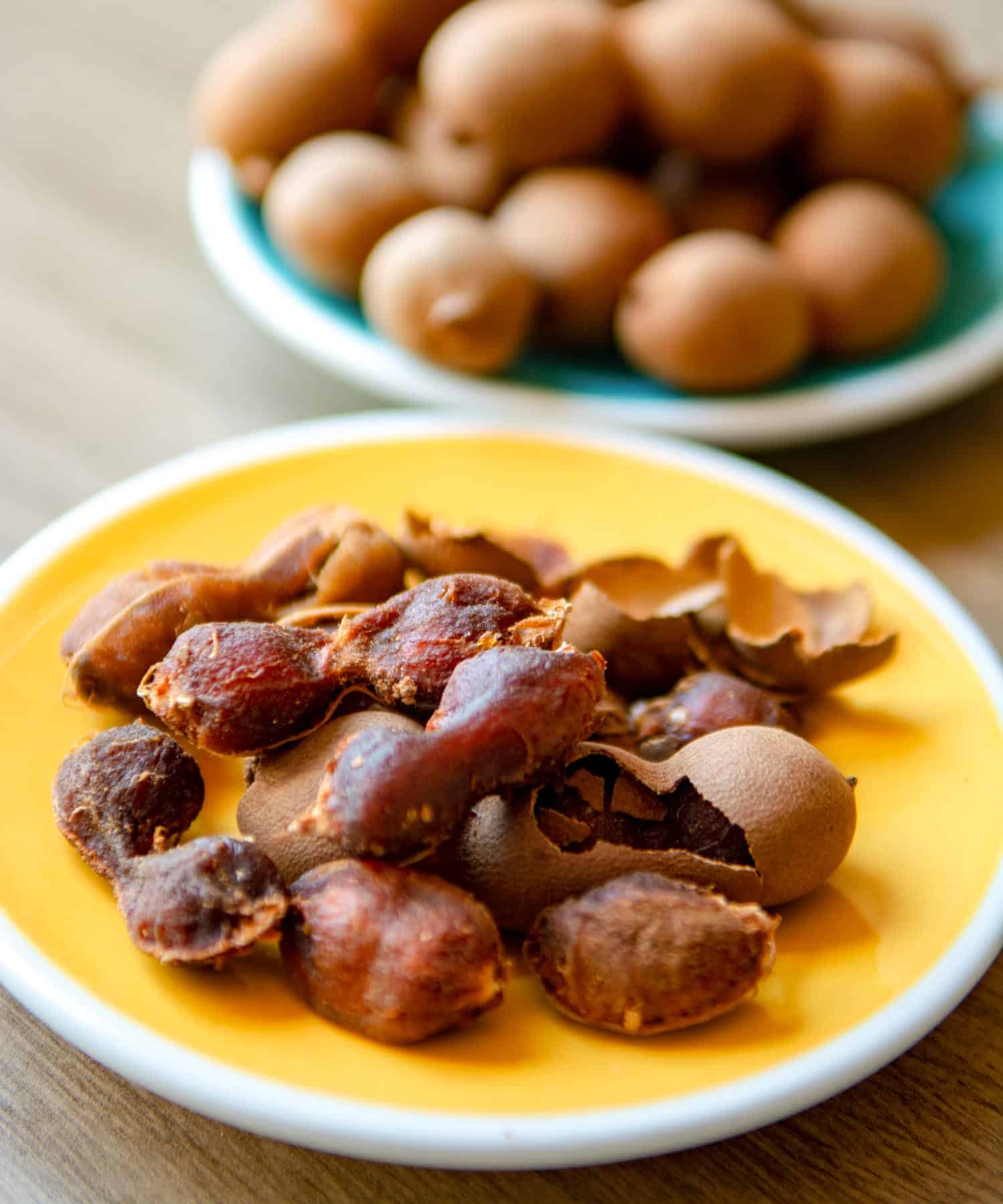
Tamarind
Often called “tambrin,” this Jamaica fruit grows four or five in a pod. It is often turned into a drink, or combined with sugar and other spices to make sweet tamarind balls
Although it can be quite sour to eat raw, many people claim to love the puckering action of eating it straight from the pod.
It is native to Africa, many believe it came to Jamaica by way of Indian labourers.
Tamarind season in Jamaica runs January through March.
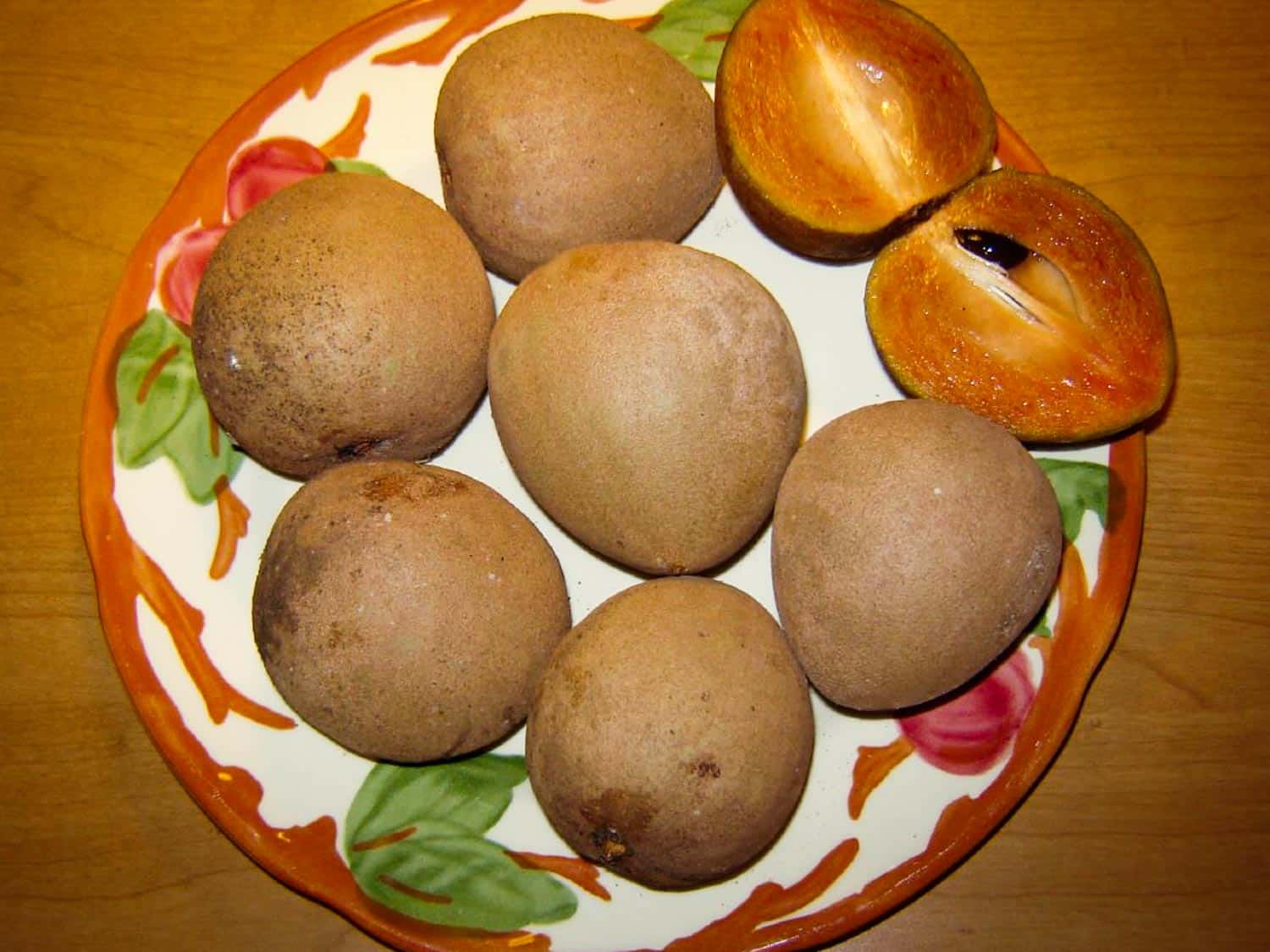
Naseberry
Part of the sapote family of fruit in Jamaica, it is also known as nispero, chikoo or sapodilla.
I love how Jamaican fruits aren’t all just bright colours and flavours.
Naseberry (neeze-bear-rhee) is native to Jamaica and has a brown skin and orange-ish brown flesh that isn’t fruity. But instead naseberry is almost spicy, with notes of cinnamon and brown sugar.
Naseberry season in Jamaica runs March through May.
Chayote
Also known as chocho and mirliton squash, chayote is often referred to as a squash, and like squash chayote is a fruit not a vegetable.
It’s actually in the gourd family and grows on a type of vine.
Chayote often look like a pear, and has a very mild flavour, almost like a cucumber.
Christmas in Jamaica
Because it’s so mild it is often used in savoury cooking, especially in stews or fried like a plantain
It is possible to eat them raw but the skin can be pretty tough. They can be peeled, marinated in lime juice and served in a fruit salad.
Kamranga
Also called jimbilin in Jamaica, which is confusing because that means there are two Jamaican fruits called jimbilian in Jamaica.
And believe me it causes a lot of arguments on Youtube videos featuring the fruit.
It is named after its star shape and is also called starfruit, and carambola in Spanish.
It is a sweet but sour Jamaican fruit and can only be eaten raw if it is very very ripe – otherwise it is simply too tart.
Most often it is turned into juice with lots of added sugar, or with other fruit to make a smoothie.
Noni
One of the most loved and despised Jamaica fruit. Noni is incredibly good for you but the smell of it is horrible and so is the strong, bitter taste.
It smells like a strong parmesan or blue cheese. Some people call it cheese fruit, others call it vomit fruit.
And yet it is also known as a miracle fruit.
It is upheld as a healing fruit from South Asia to Hawaii to Latin America and is also known as the Indian mulberry, great morinda or beach mulberry.
In all of these countries the most common way to consume noni is as juice.
It is widely believed in the world of natural medicine that that noni can heal everything from asthma to impotence to cancer.
It has been turned into fruit powder, tonics and capsules.
It thrives in volcanic soil and grows well in Jamaica as it is believed Jamaica was created by prehistoric volcanoes.
Sugar Cane
Sugar cane is technically not a fruit in Jamaica but an edible grass. But I wanted to include it as it has so many ties to its history, and is one of the plants to eat in Jamaica.
It is one of the crops Christopher Colombus brought to Jamaica. That was a gift with a steep price as it also brought institutional slavery along with it on the sugar plantations.
Today, sugar cane is an important crop as it is used to make sugar and rum. But it is also commonly eaten as snacks, cut up into smaller chunks and sold in small bags.
You cannot bite through unprocessed sugar cane. Instead you just kind of chew or gnaw on it to release the juice and then throw out the fibrous remains.
Pin it: Jamaica Fruit
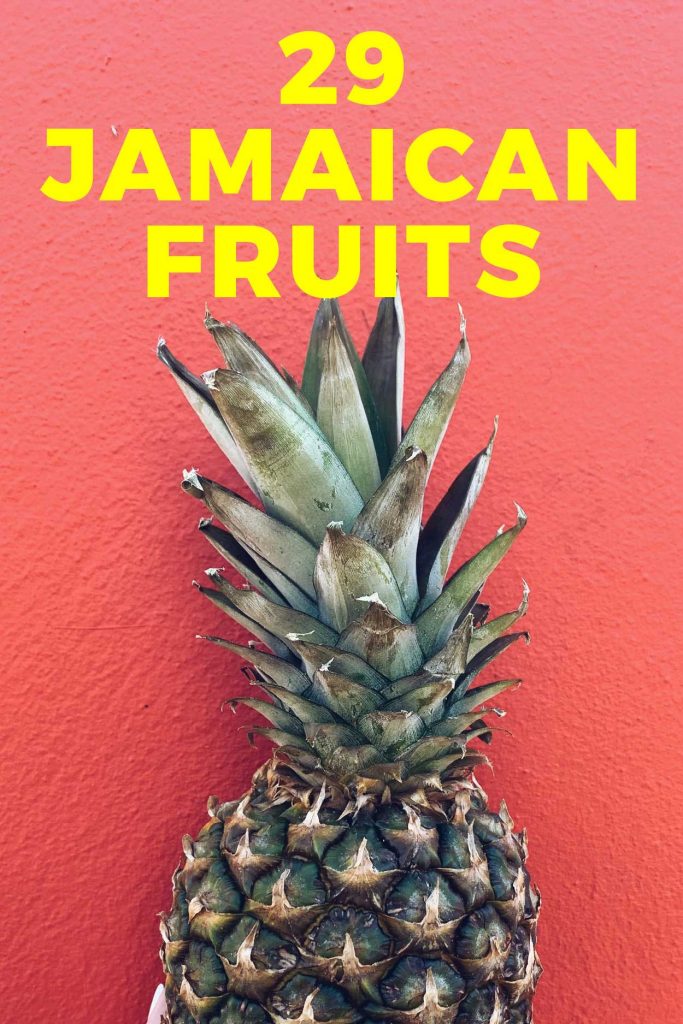
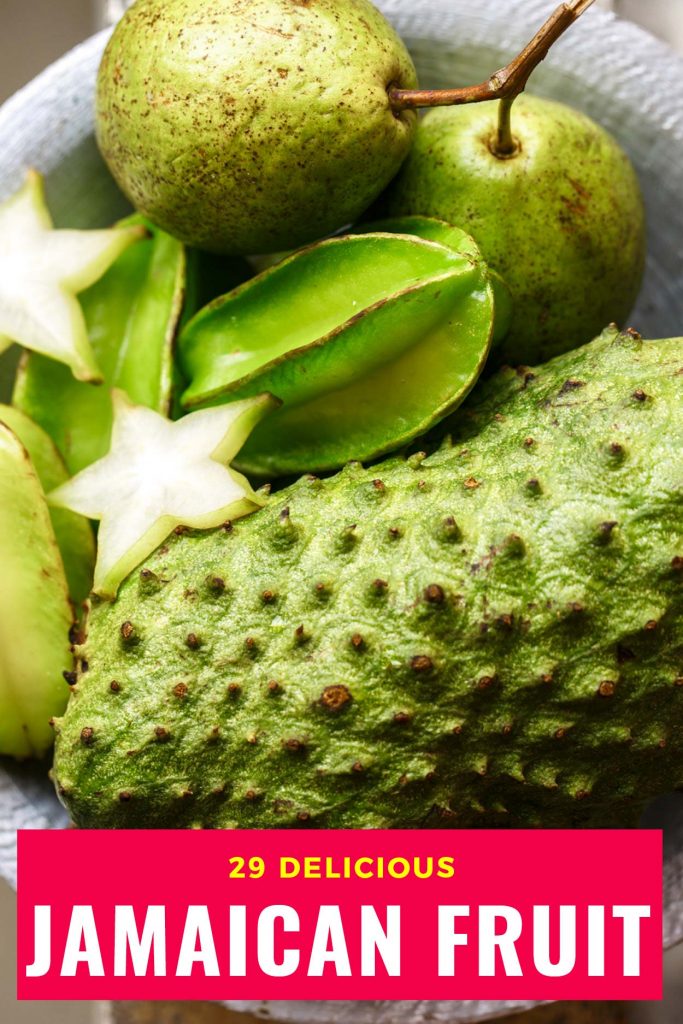
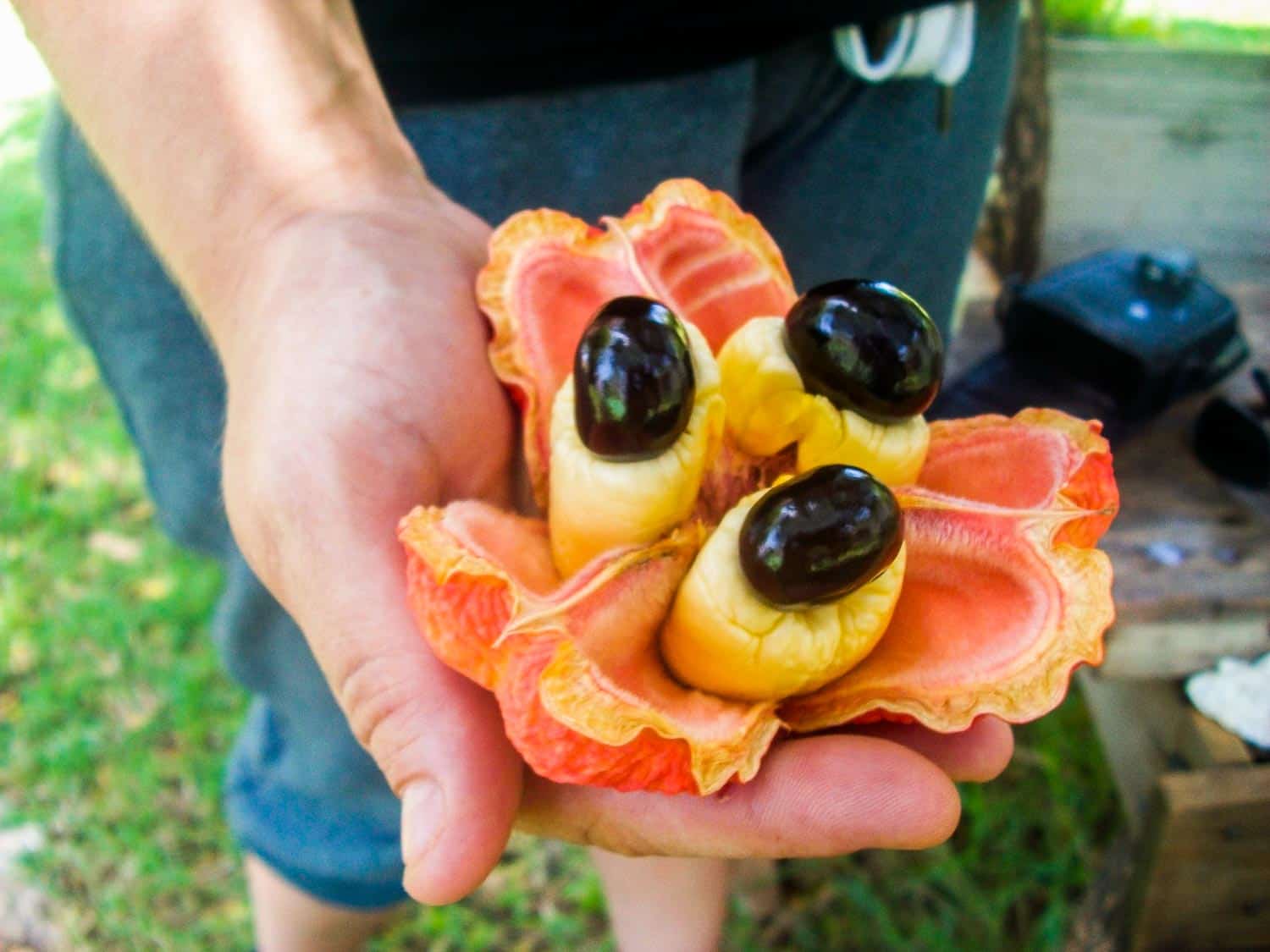
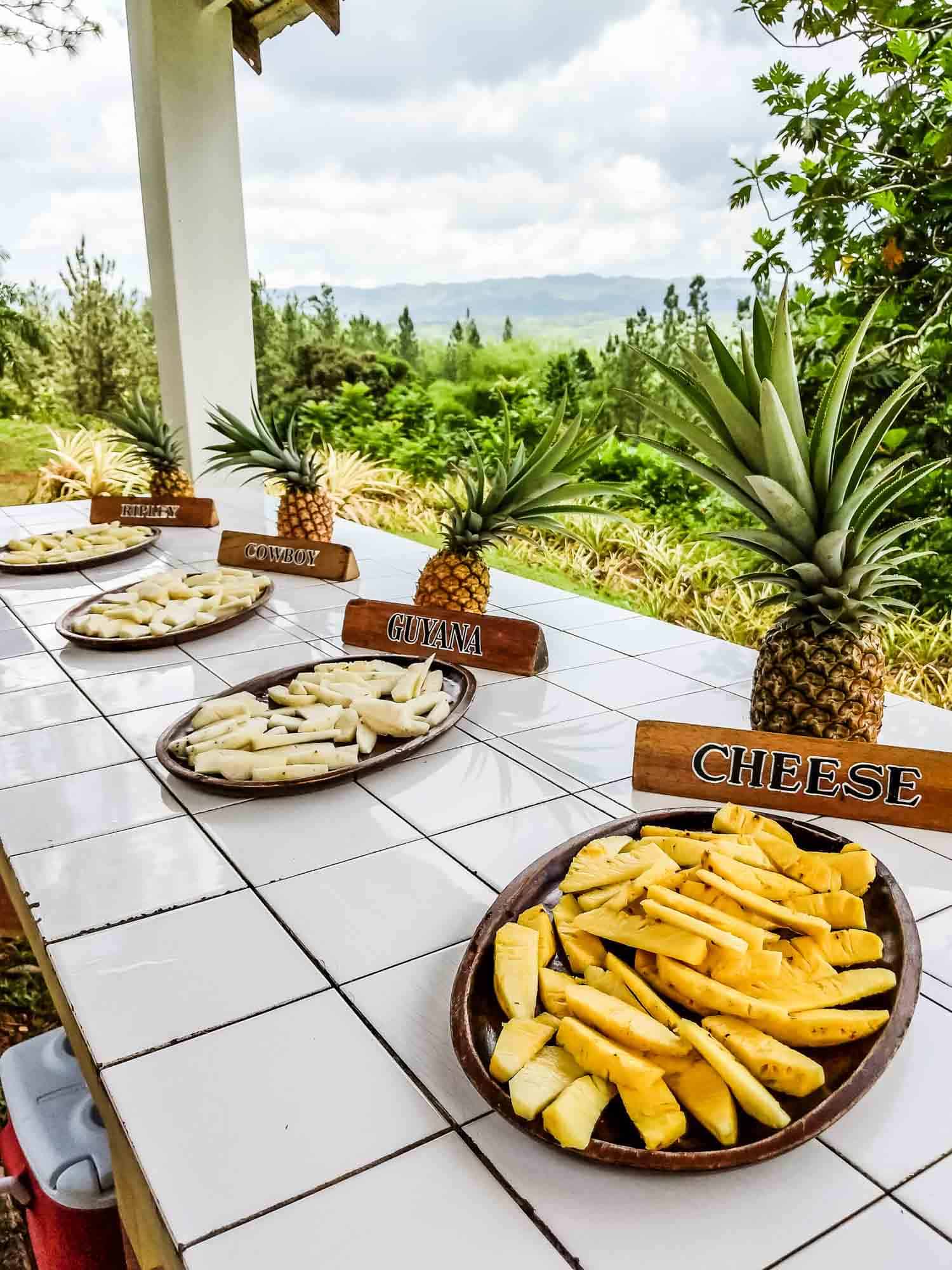
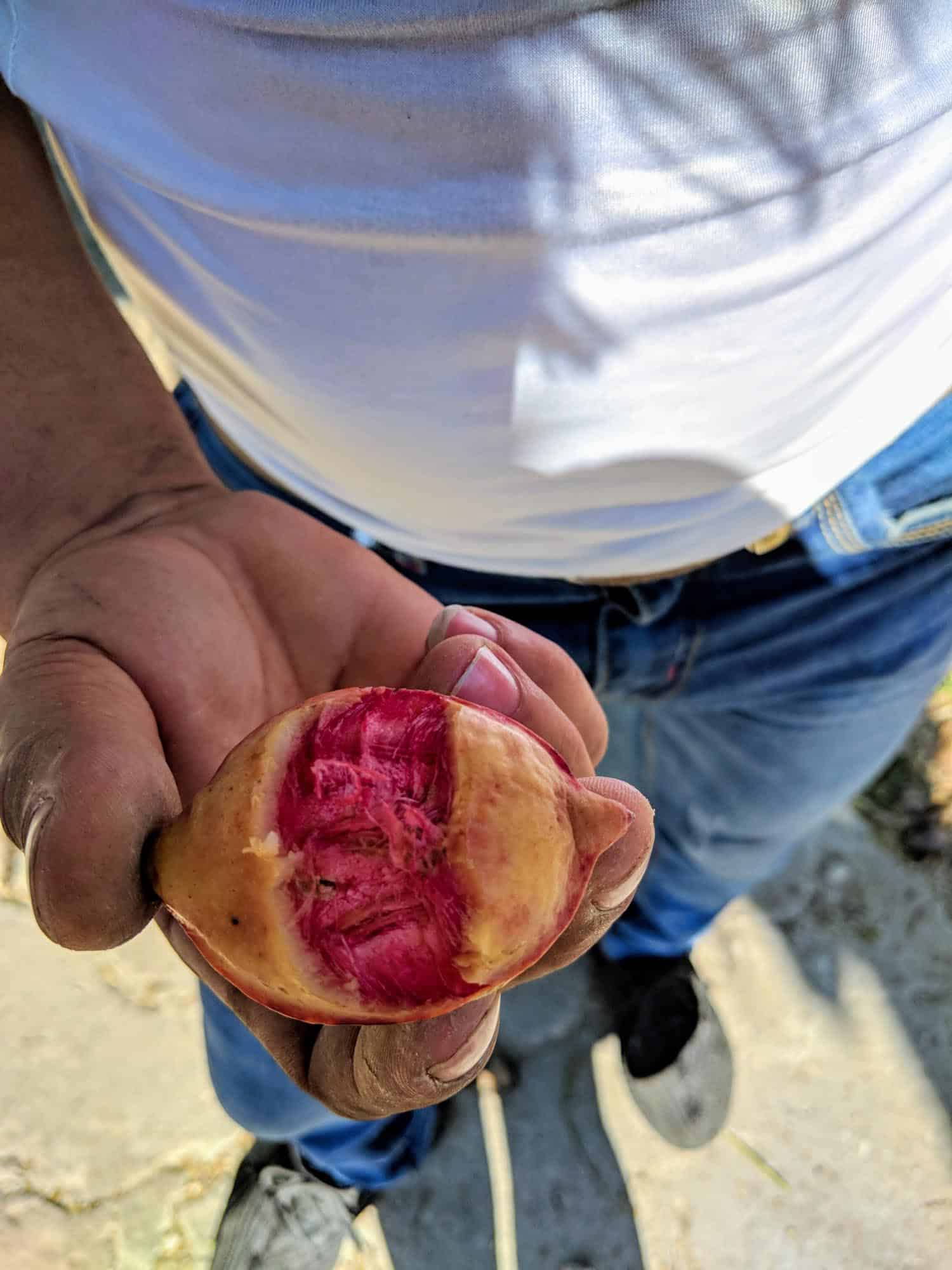

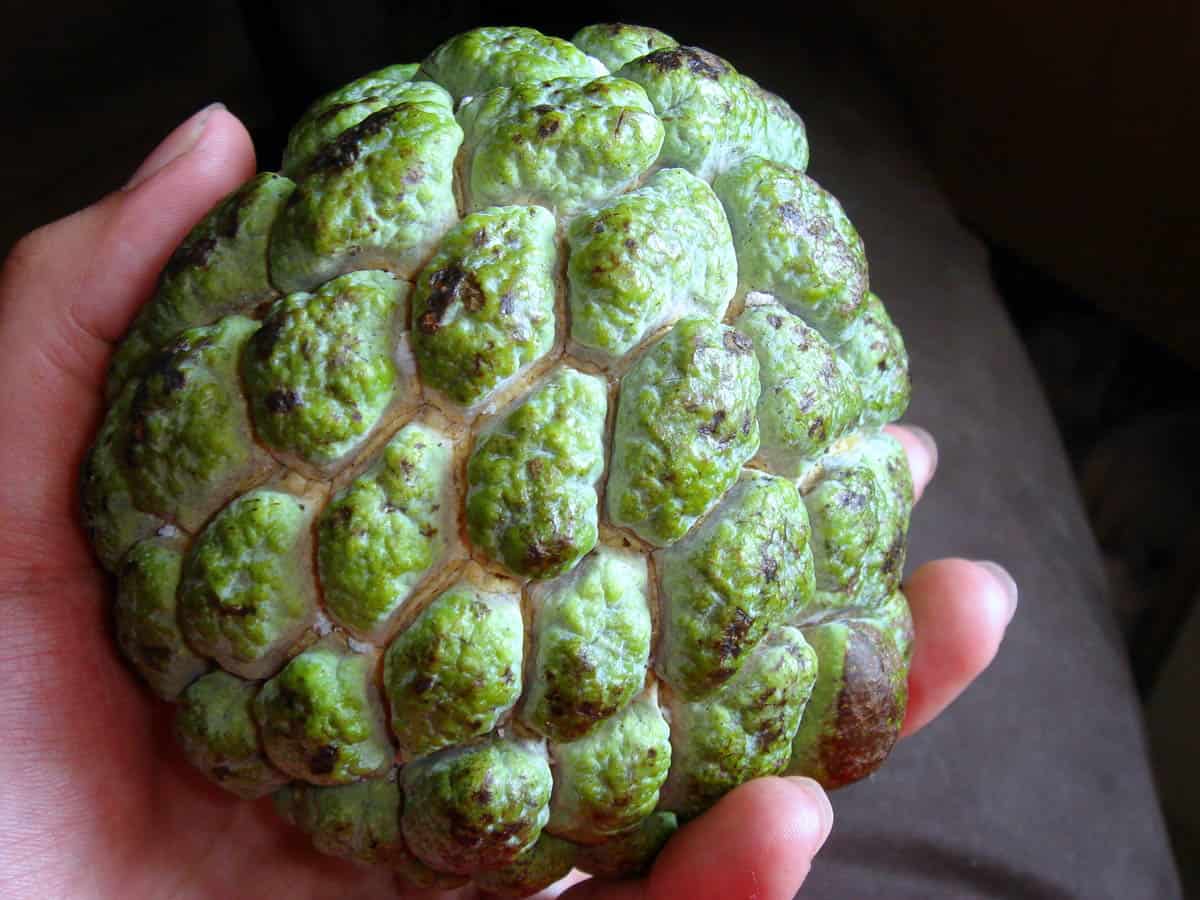
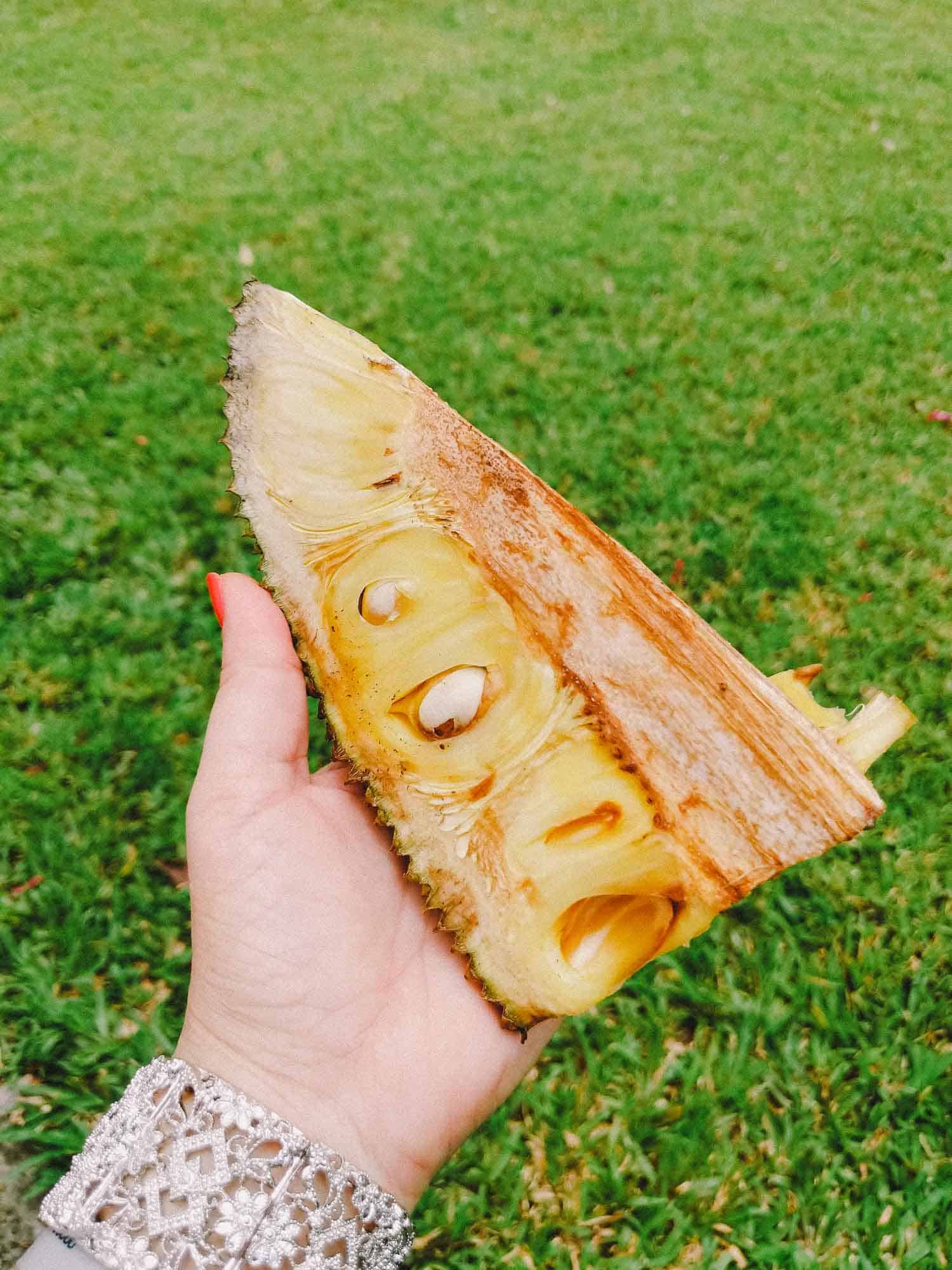
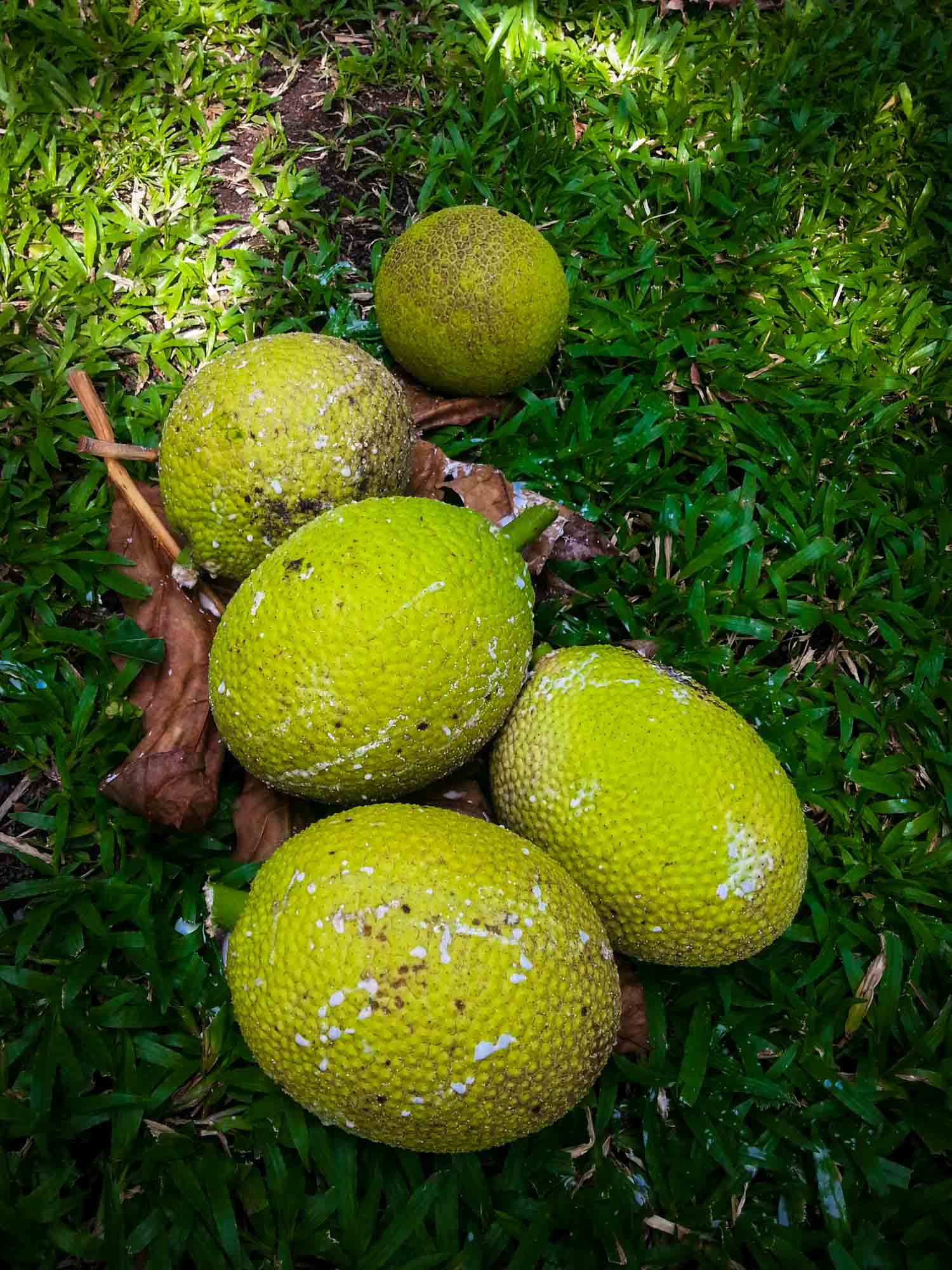
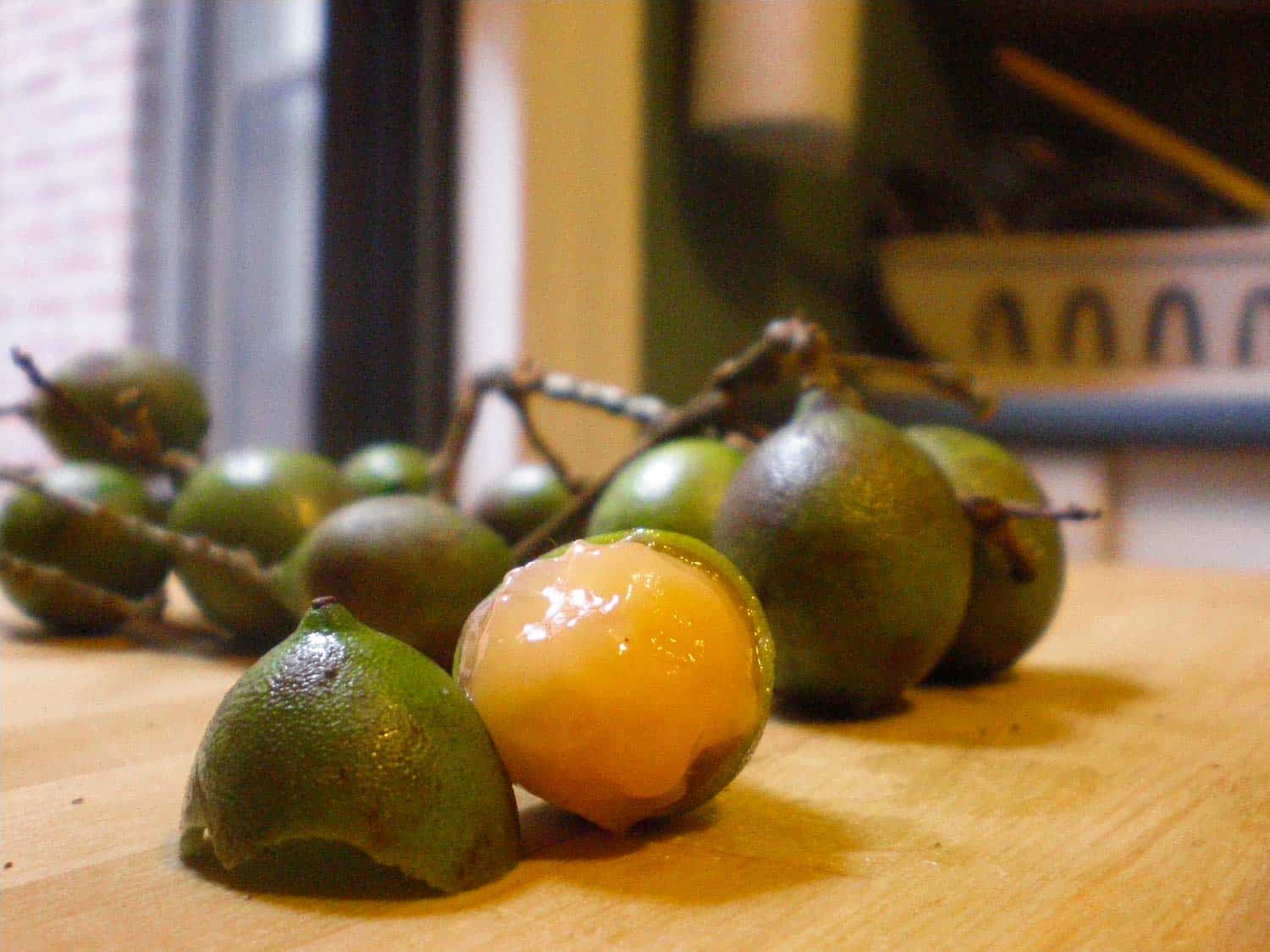
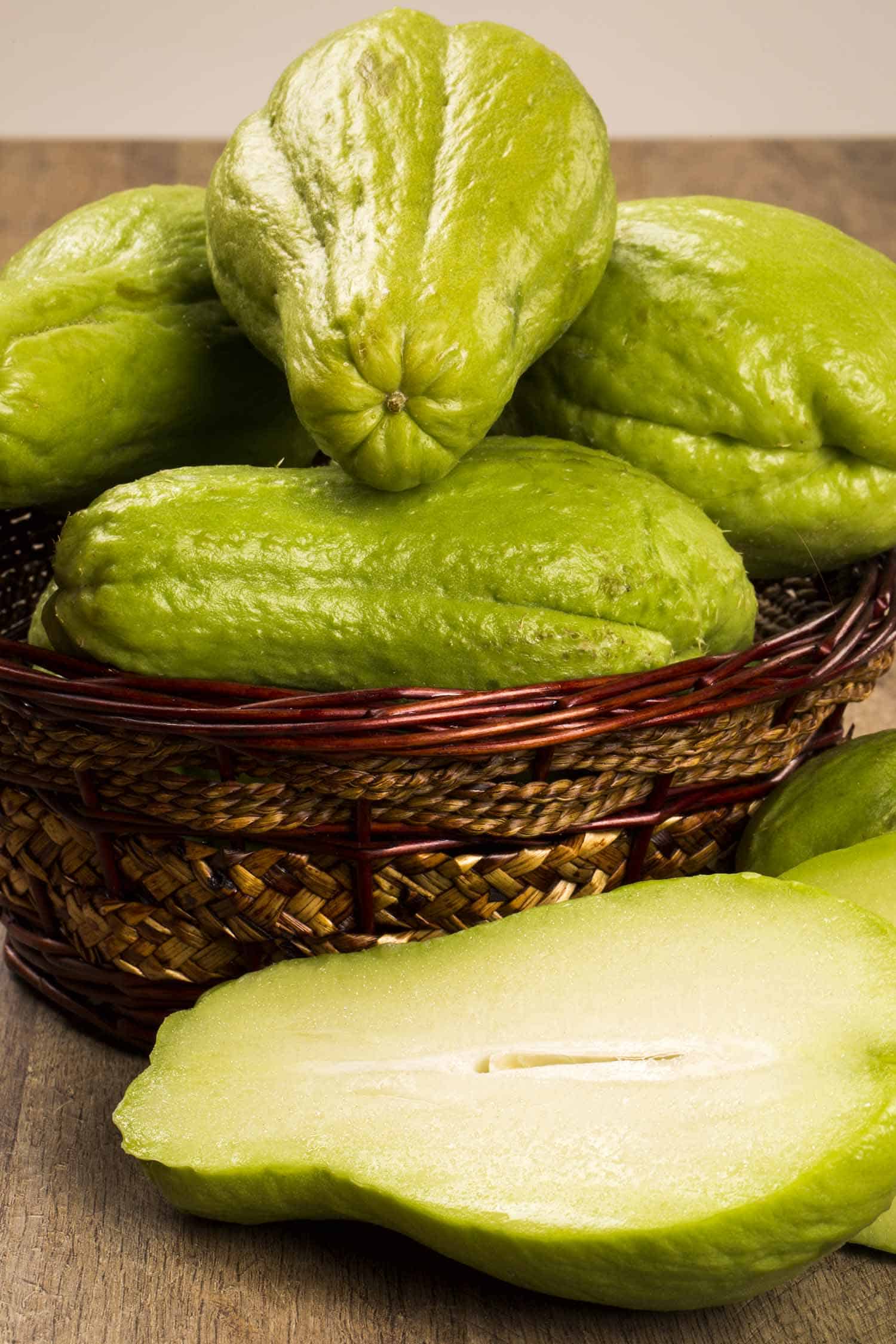
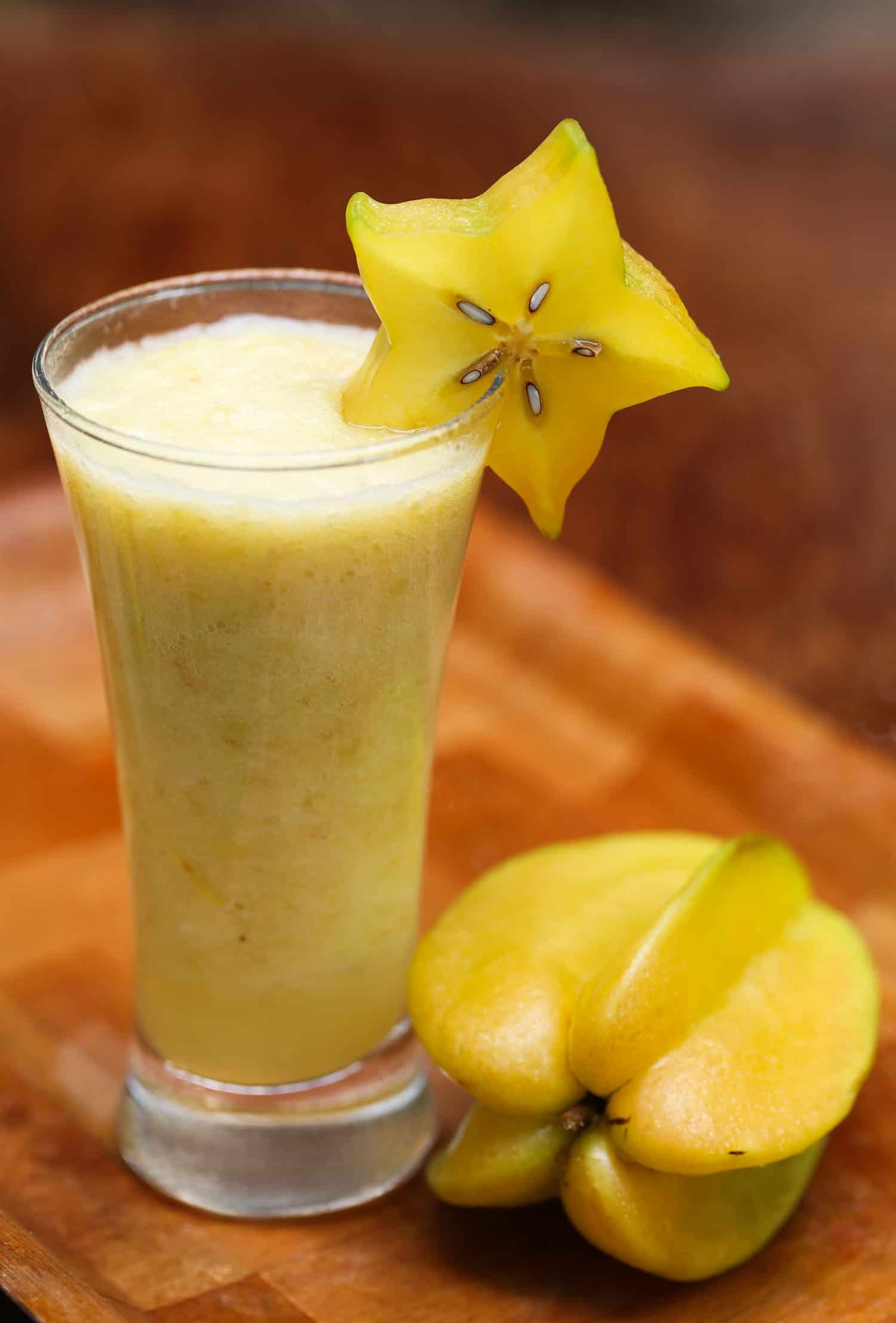
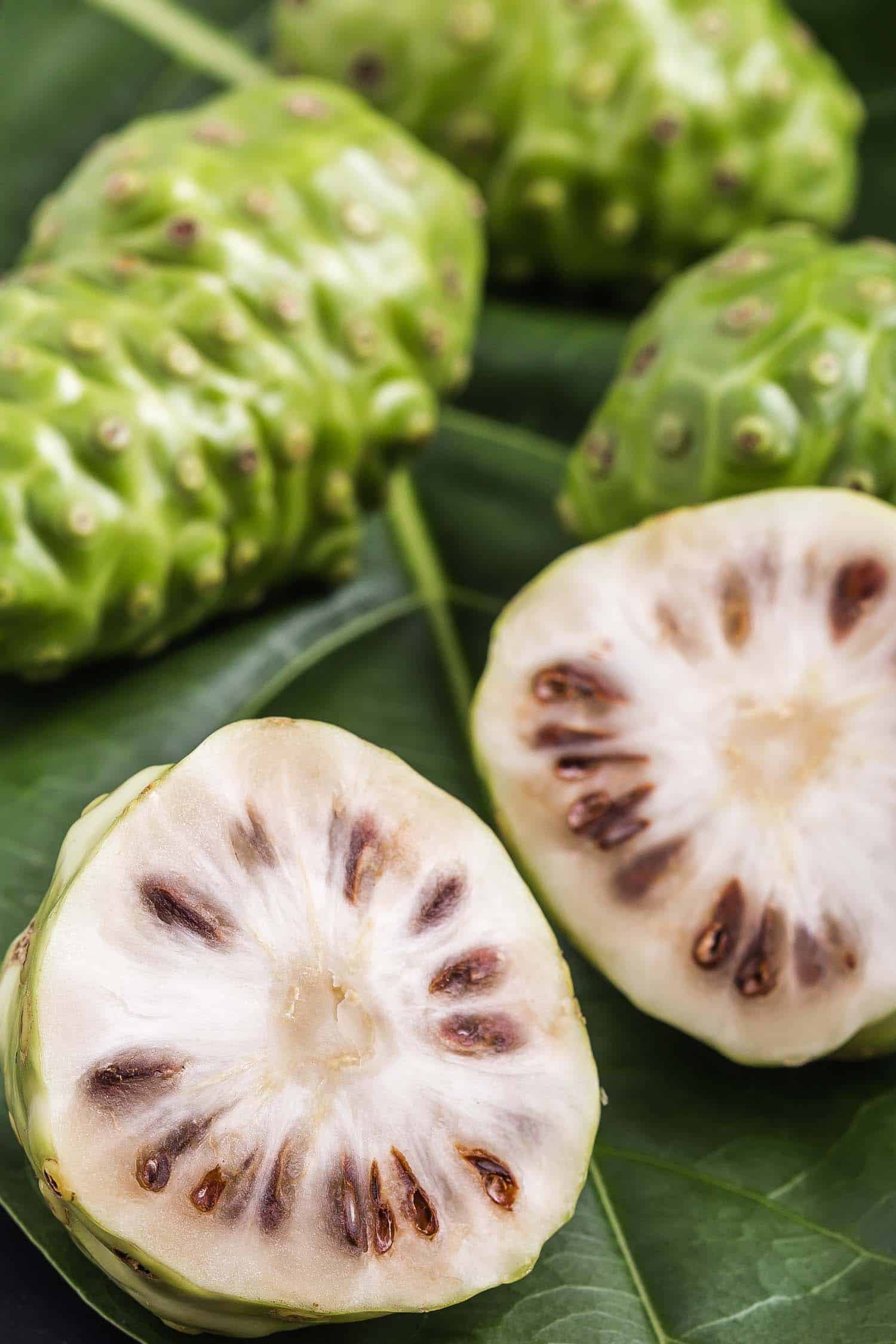
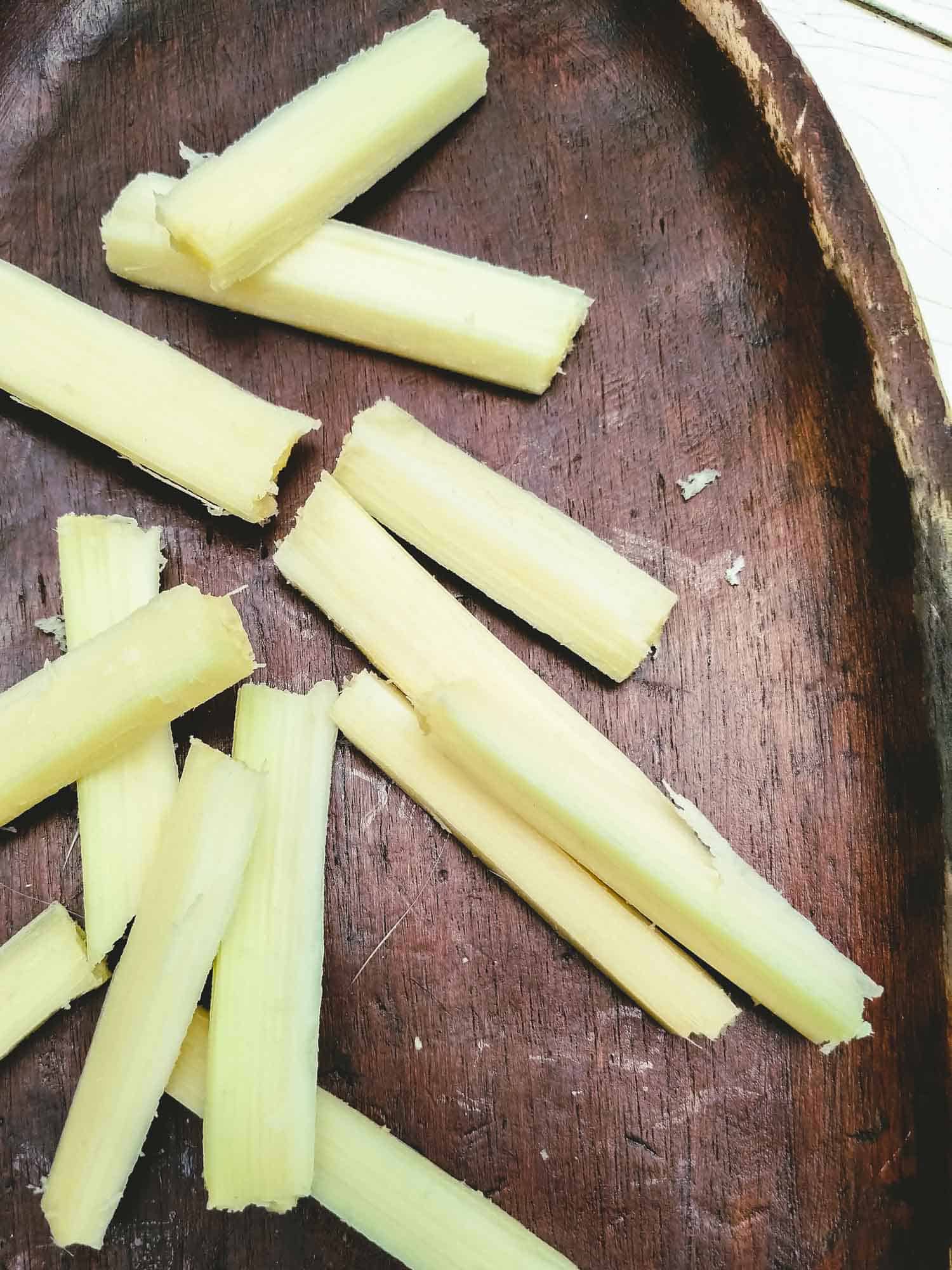
They all look so good. Would it be great to be able to travel to taste them all.
No, they are not. We too have a fruit called custard apple in Jamaica. However, it differs from sweetsop and soursop which look and have their own distinct features.
So many awesome fruits here. And many I would love to try.
The sweetsop/soursop looks like custard apple. Is it the same?
Here in Cambodia, there is a variety of mango that is eaten green. It is usually a bit sour and a bit crunchy and you dip slices into a chilli salt, made from chilli, salt and sometimes sugar. I love it.
It could be. They are all the same family of fruit.
Custard apple is also called Cherimoya: annona chermola
Soursop is annona muricata
Sweetsop is annona squamosa
Soursop is spikey and larger tastes like kiwi/pineapple/pear.
Sweetsop is bumpy and small like an apple – also called sugar apple. But it looks like in South East Asia there is both cherimoya (annona chermola) and sweetsop (annona squamosa) and both are called custard apple.
Have a look at this post as the first fruit I mention is cherimoya and the second is soursop and there are photos for both.
https://www.baconismagic.ca/food/exotic-fruits/
Let me know which one it is.
Hi Jonathan, our cherries are acerola and commonly referred to as Barbados cherries. Thanks for sharing your list; most of which name fruits I enjoy at home.
I love my fruit and these all sound so refreshing and delicious. I hadn’t heard of a few before!
I could not even fathom that Jamaica has such unique fruits. Thank you for sharing such wonderfully edible information:-) Great going!
Thank you Ayngelina!
Very educational! My partner is Jamaican and 70 years old. He has lived in the UK since the 80’s. He really enjoyed the reminiscing whilst reading this article. So I thank you for that.
What about Coolie Plums?
I was really looking forward to seeing it in the list.
I love the mango list! Yum.
I grew up eating a lot on this list.
Your article makes for good reminiscing with my family
Thank you
I have never seen coolie plums before, are they are fruit in Jamaica you can find everywhere?
Hi Omena
Is coolie plum the same as hog plum?
Hello Ayngelina,
Your article on 25 Jamaican fruits was interesting and enjoyable. Now, I hope you’ll be able to help me. A few years ago, I was given a small red fruit shaped like a pepper light and it grew on a tree that had leaves like that of maples. At the time, the tree was growing in a friend’s garden in St. Catherine here in Jamaica. Would you know the name of that fruit? I never knew and although my friend knew it was edible, she could not remember the name. My research has failed to yield either name or identity of the fruit. Thanks for any shared insights!
Is coolie the same as hog plum? The jimbilin debate is as old as time lol. One more thing, kidney mangoes are different from black mangoes…..
Thanks for this list!!! I didn’t know there were so many mango varieties in Jamaica
Coolie plums may be found in several places here in Jamaica. There are common ones referred to as red coat or yellow plums. These grow in my yard and children love them.
Greetings Ayngelina,
My name is Jonathan, I’m from Jamaica. I’d like to congratulate you on your hard work and awesome knowledge of not only Jamaican fruits, but much more! I am really impressed with what you were able to find! Like a previous reader, I will mention “coolie plums,” I will also add the following for you to search out and try:
govenor’s plum
rose apple
the non hairy/ regular lychee
common plum (the reddish ones & the green ones)
Jamaican cherries (regular wild cherries found in JA)
Ribena
Passion fruit
If I think of more, I’ll add them later… but, thank you, sincerely! I love fruits, every country I visit I always go out of my way to learn more about the fruits and native species. Please do a list on Belize, Mexico and Colombia; I’m sure you’ll enjoy what you find as much as I did.
God bless
Hi Jonathan, our cherries are acerola and commonly referred to as Barbados cherries. Thanks for sharing your list; most of which name fruits I enjoy at home.
I am in Martinique and it’s amazing to learn the english names of the fruits we have here. Very educational ! Thank you
During a trip to Jamaica in 96, we took an amazing and wonderful raft ride down the Rio Grand River. Our expert guide Roy told us about all the different flora and fauna along the river. He stopped the raft in many spots during our ride. Once he used a long bamboo pole for knocking several fruit out of a tree along the river’s edge. The fruit fell in the river, we scooped them all up. They were small yellow apple shaped fruit. Roy called them “Drunken Apples”. And if you ate too many, they would make you feel drunk!
I can’t find anything about them on the internet. Delicious little things! And yes, we had a buzz from eating only a few!
As I mentioned, it was on the Rio Grand River and the tree was right along the river bank.
I highly recommend a raft ride down the Rio Grand River if your ever in Jamaica! Wonderful experience with expert guides. I will remember it forever.
YOU’RE. NOT YOUR.